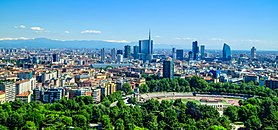Milan
Milan
Milano (Italian) | |
|---|---|
| Comune di Milano | |
|
| |
| Coordinates: 45°28′01″N 09°11′24″E / 45.46694°N 9.19000°E | |
| Country | Italy |
| Region | |
| Metropolitan city | |
| Government | |
| • Type | Strong Mayor–Council |
| • Mayor | Giuseppe Sala |
| • Legislature | Milan City Council |
| Area | |
| • Comune | 181.76 km2 (70.18 sq mi) |
| Elevation | 120 m (390 ft) |
| Population (31 December 2023)[1] | |
| • Comune | 1,417,597 |
| • Density | 7,800/km2 (20,000/sq mi) |
| • Metro | 4,336,121 |
| Demonym(s) | Milanese Meneghino[3] |
| GDP | |
| • Metro | €204,514 billion (2020) |
| Time zone | UTC+1 (CET) |
| • Summer (DST) | UTC+2 (CEST) |
| Area code | 0039 02 |
| Website | www.comune.milano.it |
 | |
| Click on the map for a fullscreen view | |
Milan (/mɪˈlæn/ mil-AN, US also /mɪˈlɑːn/ mil-AHN,[5][6] Milanese: [miˈlãː] ; Italian: Milano [miˈlaːno] ) is a city in northern Italy, regional capital of Lombardy, the largest city in Italy by urban population[7] and the second-most-populous city proper in Italy after Rome. The city proper has a population of about 1.4 million,[8] while its metropolitan city has 3.22 million residents.[9] The urban area of Milan is the fourth-most-populous in the EU with 6.17 million inhabitants.[10] According to national sources, the population within the wider Milan metropolitan area (also known as Greater Milan) is estimated between 7.5 million and 8.2 million, making it by far the largest metropolitan area in Italy and one of the largest in the EU.[11][12] Milan is the economic capital of Italy, one of the economic capitals of Europe and a global financial centre.[13][14]
Milan is a leading alpha global city, with strengths in the fields of art, chemicals, commerce, design, education, entertainment, fashion, finance, healthcare, media (communication), services, research, and tourism.[15][16] Its business district hosts Italy's stock exchange (Italian: Borsa Italiana), and the headquarters of national and international banks and companies. In terms of GDP, Milan is the wealthiest city in Italy, having also one of the largest economies among EU cities.[17][18] Milan is viewed along with Turin as the southernmost part of the Blue Banana urban development corridor (also known as the "European Megalopolis"), and one of the Four Motors for Europe. Milan is a major international tourist destination, appearing among the most visited cities in the world, ranking second in Italy after Rome, fifth in Europe and sixteenth in the world.[19][20] Milan is a major cultural centre, with museums and art galleries that include some of the most important collections in the world, such as major works by Leonardo da Vinci.[21][22] It also hosts numerous educational institutions, academies and universities, with 11% of the national total of enrolled students.[23][24]
Founded around 590 BC[25] under the name Medhelanon by a Celtic tribe belonging to the Insubres group and belonging to the Golasecca culture, it was conquered by the ancient Romans in 222 BC, who Latinized the name of the city into Mediolanum.[25][26] The city's role as a major political centre dates back to the late antiquity, when it served as the capital of the Western Roman Empire.[27] From the 12th century until the 16th century, Milan was one of the largest European cities and a major trade and commercial centre, as the capital of the Duchy of Milan, one of the greatest political, artistic and fashion forces in the Renaissance.[28][29] Having become one of the main centres of the Italian Enlightenment during the early modern period, it then became one of the most active centres during the Restoration, until its entry into the unified Kingdom of Italy. From the 20th century onwards Milan became the industrial and financial capital of Italy.[30][31]
Milan has been recognized as one of the world's four fashion capitals.[32] Many of the most famous luxury fashion brands in the world have their headquarters in the city, including: Armani, Prada, Versace, Valentino, Loro Piana and Zegna.[33][34] It also hosts several international events and fairs, including Milan Fashion Week and the Milan Furniture Fair, which are among the world's biggest in terms of revenue, visitors and growth.[35][36][37] The city is served by many luxury hotels and is the fifth most starred in the world by Michelin Guide.[38] It hosted the Universal Exposition in 1906 and 2015. In the field of sports, Milan is home to two of Europe's most successful football teams, AC Milan and Inter Milan, and one of Europe's main basketball teams, Olimpia Milano. Milan will host the Winter Olympic and Paralympic games for the first time in 2026, together with Cortina d'Ampezzo.[39][40][41]
Toponymy
[edit]
Milan was founded with the Celtic name of Medhelanon,[26][25] later Latinized by the ancient Romans into Mediolanum. In Celtic language medhe- meant "middle, centre" and the name element -lanon is the Celtic equivalent of Latin -planum "plain", meant "(settlement) in the midst of the plain",[42][43] or of "place between watercourses" (Celtic medhe = "in the middle, central"; land or lan = "land"), given the presence of the Olona, Lambro, Seveso rivers and the Nirone and Pudiga streams.[44]
The Latin name Mediolanum comes from the Latin words medio (in the middle) and planus (plain).[45] However, some scholars believe that lanum comes from the Celtic root lan, meaning an enclosure or demarcated territory (source of the Welsh word llan, meaning "a sanctuary or church", ultimately cognate to English/German Land) in which Celtic communities used to build shrines.[46]
Hence Mediolanum could signify the central town or sanctuary of a Celtic tribe. Indeed, about sixty Gallo-Roman sites in France bore the name "Mediolanum", for example: Saintes (Mediolanum Santonum) and Évreux (Mediolanum Aulercorum).[47] In addition, another theory links the name to the scrofa semilanuta ("half-woolly sow") an ancient emblem of the city, fancifully accounted for in Andrea Alciato's Emblemata (1584), beneath a woodcut of the first raising of the city walls, where a boar is seen lifted from the excavation, and the etymology of Mediolanum given as "half-wool",[48] explained in Latin and in French.
According to this theory, the foundation of Milan is credited to two Celtic peoples, the Bituriges and the Aedui, having as their emblems a ram and a boar;[49] therefore "The city's symbol is a wool-bearing boar, an animal of double form, here with sharp bristles, there with sleek wool."[50] Alciato credits Ambrose for his account.[51]
History
[edit]Celtic era
[edit]
Around 590 BC[25] a Celtic tribe belonging to the Insubres group and belonging to the Golasecca culture settled the city under the name Medhelanon.[26][25] According to the legend reported by Livy (writing between 27 and 9 BC), the Gaulish king Ambicatus sent his nephew Bellovesus into northern Italy at the head of a party drawn from various Gaulish tribes; Bellovesus allegedly founded the settlement in the times of the Roman monarchy, during the reign of Tarquinius Priscus. Tarquin is traditionally recorded as reigning from 616 to 579 BC, according to ancient Roman historian Titus Livy.[52]
Medhelanon, in particular, was developed around a sanctuary, which was the oldest area of the village.[53] The sanctuary, which consisted of a wooded area in the shape of an ellipse with a central clearing, was aligned according to precise astronomical points. For this reason, it was used for religious gatherings, especially in particular celebratory moments. The sanctuary of Medhelanon was an ellipse with axes of 443 m (1,453 ft) and 323 m (1,060 ft) located near Piazza della Scala.[53] The urban planning profile was based on these early paths, and on the shape of the sanctuary, reached, in some cases, up to the 19th century and even beyond. For example, the route of the modern Corso Vittorio Emanuele, Piazza del Duomo, Piazza Cordusio and Via Broletto, which is curvilinear, could correspond to the south side of the ellipse of the ancient sanctuary of Medhelanon.[53]
One axis of the Medhelanon sanctuary was aligned towards the heliacal rising of Antares, while the other towards the heliacal rising of Capella. The latter coincided with a Celtic spring festival celebrated on 24 March, while the heliacal rising of Antares corresponded with 11 November, which opened and closed the Celtic year and which coincided with the point where the Sun rose on the winter solstice.[53] About two centuries after the creation of the Celtic sanctuary, the first residential settlements began to be built around it. Medhelanon then transformed from a simple religious center to an urban and then military centre, thus becoming a real village.[53]
The first homes were built just south of the Celtic sanctuary, near the modern Royal Palace of Milan.[53] Subsequently, with the growth of the town centre, other important buildings for the Medhelanon community were built. First, a temple dedicated to the goddess Belisama was built, which was located near the modern Milan Cathedral. Then, near the modern Via Moneta, which is located near today's Piazza San Sepolcro, a fortified building with military functions was built which was surrounded by a defensive moat.[53]
Roman times
[edit]
During the Roman Republic, the Romans, led by consul Gnaeus Cornelius Scipio Calvus, fought the Insubres and captured the settlement in 222 BC. The chief of the Insubres then submitted to Rome, giving the Romans control of the settlement.[54] The Romans eventually conquered the entirety of the region, calling the new province "Cisalpine Gaul" (Latin: Gallia Cisalpina)—"Gaul this side of the Alps"—and may have given the city its Latinized name of Mediolanum: in Gaulish *medio- meant "middle, centre" and the name element -lanon is the Celtic equivalent of Latin -planum "plain", thus *Mediolanon (Latinized as Mediolānum) meant "(settlement) in the midst of the plain".[43][55] Mediolanum became the most important center of Cisalpine Gaul and, in the wake of economic development, in 49 BC, was elevated, within the Lex Roscia, to the status of municipium.[56]


The ancient Celtic settlement was, from a topographic point of view, superimposed and replaced by the Roman one. The Roman city was then gradually superimposed and replaced by the medieval one. The urban center of Milan has therefore grown constantly and rapidly, until modern times, around the first Celtic nucleus. The original Celtic toponym Medhelanon then changed, as evidenced by a graffiti in Celtic language present on a section of the Roman walls of Milan which dates back to a period following the Roman conquest of the Celtic village, in Mesiolano.[57] In 286, the Roman Emperor Diocletian moved the capital of the Western Roman Empire from Rome to Mediolanum.[58] Diocletian himself chose to reside at Nicomedia in the Eastern Empire, leaving his colleague Maximian at Milan.
During the Augustan age Mediolanum was famous for its schools; it possessed a theatre and an amphitheatre (129.5 x 109.3 m), the third largest in Roman Italy after the Colosseum in Rome and the vast amphitheatre in Capua.[59] A large stone wall encircled the city in Caesar's time, and later was expanded in the late third century AD, by Maximian. Maximian built several gigantic monuments including the large circus (470 × 85 metres) and the thermae or Baths of Hercules, a large complex of imperial palaces and other services and buildings of which few visible traces remain. Maximian increased the city area to 375 acres by surrounding it with a new, larger stone wall (about 4.5 km long) with many 24-sided towers. The monumental area had twin towers; the one included later in the construction of the convent of San Maurizio Maggiore remains 16.6 m high.
It was from Mediolanum that the Emperor Constantine issued what is now known as the Edict of Milan in AD 313, granting tolerance to all religions within the Empire, thus paving the way for Christianity to become the dominant religion of the Empire. Constantine was in Mediolanum to celebrate the wedding of his sister to the Eastern Emperor, Licinius. In 402, the Visigoths besieged the city and the Emperor Honorius moved the Imperial residence to Ravenna.[60] In 452, Attila besieged the city, but the real break with the city's Imperial past came in 539, during the Gothic War, when Uraias (a nephew of Witiges, formerly King of the Italian Ostrogoths) carried out attacks in Milan, with losses, according to Procopius, being about 300,000 men. The Lombards took Ticinum as their capital in 572 (renaming it Papia – the modern Pavia), and left early-medieval Milan to the governance of its archbishops.
Middle Ages
[edit]
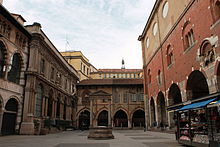
After the siege of the city by the Visigoths in 402, the imperial residence moved to Ravenna. Attila, King of the Huns, sacked and devastated the city in 452 AD. In 539 the Ostrogoths conquered and destroyed Milan during the Gothic War against Byzantine Emperor Justinian I. In the summer of 569 the Lombards (from whom the name of the Italian region Lombardy derives), conquered Milan, overpowering the small Byzantine garrison left for its defence. Some Roman structures remained in use in Milan under Lombard rule.[61] Milan surrendered to Charlemagne and the Franks in 774.
The 11th century saw a reaction against the control of the Holy Roman Emperors. City-states emerged in northern Italy, an expression of the new political power of the cities and their will to fight against all feudal powers. Milan was no exception. It did not take long, however, for the Italian city-states to begin fighting each other to try to limit neighbouring powers.[62] The Milanese destroyed Lodi and continuously warred with Pavia, Cremona and Como, who in turn asked Frederick I Barbarossa for help. In a sally they captured Empress Beatrice and forced her to ride a donkey backward through the city until getting out. Frederick I Barbarossa brought the destruction of much of Milan in 1162.[63][64]
A period of peace followed and Milan prospered as a centre of trade due to its geographical position. During this time, the city was considered one of the largest European cities.[28] As a result of the independence that the Lombard cities gained in the Peace of Constance in 1183, Milan returned to the commune form of local government first established in the 11th century.[65][66]
In 1395, Gian Galeazzo Visconti became the first Duke of Milan upon receiving the title from Wenceslaus, King of the Romans. In 1447 Filippo Maria Visconti, Duke of Milan, died without a male heir; following the end of the Visconti line, the Ambrosian Republic was established; it took its name from St. Ambrose, the popular patron saint of the city.[67] Both the Guelph and the Ghibelline factions worked together to bring about the Ambrosian Republic in Milan. Nonetheless, the Republic collapsed when, in 1450, Milan was conquered by Francesco I of the House of Sforza, which made Milan one of the leading cities of the Italian Renaissance.[67][68] Under the House of Sforza, Milan experienced a period of great prosperity, which in particular saw the development of mulberry cultivation and silk processing.[69]
Following this economic growth, works such as the Sforza Castle (already existing in the Visconti era under the name of Porta Giovia Castle, but re-adapted, enlarged and completed by the Sforza family) and the Ospedale Maggiore were completed. The Sforzas also managed to attract to Milan personalities such as Leonardo da Vinci, who redesigned and improved the function of the navigli and painted The Last Supper, and Bramante, who worked on the church of Santa Maria presso San Satiro, on the basilica of Sant'Ambrogio and to the church of Santa Maria delle Grazie, influencing the development of the Lombard Renaissance.
Early modern
[edit]

Milan's last independent ruler, Lodovico il Moro, requested the aid of Charles VIII of France against the other Italian states, eventually unleashing the Italian Wars. The king's cousin, Louis of Orléans, took part in the expedition and realized most of Italy was virtually defenseless. This prompted him to come back a few years later in 1500, and claim the Duchy of Milan for himself, his grandmother having been a member of the ruling Visconti family. At that time, Milan was also defended by Swiss mercenaries. After the victory of Louis's successor François I over the Swiss at the Battle of Marignan, the duchy was promised to the French king François I. When the Spanish Habsburg Emperor Charles V defeated François I at the Battle of Pavia in 1525, northern Italy, which included Milan, passed to Habsburg Spain.[70]
In 1556, Charles V abdicated in favour of his son Philip II and his brother Ferdinand I. Charles's Italian possessions, including Milan, passed to Philip II and remained with the Spanish line of Habsburgs, while Ferdinand's Austrian line of Habsburgs ruled the Holy Roman Empire. The Great Plague of Milan in 1629–31, that claimed the lives of an estimated 60,000 people out of a population of 130,000, caused unprecedented devastation in the city and was effectively described by Alessandro Manzoni in his masterpiece The Betrothed. This episode was seen by many as the symbol of Spanish bad rule and decadence and is considered one of the last outbreaks of the centuries-long pandemic of plague that began with the Black Death.[71]
In 1700, the Spanish line of Habsburgs was extinguished with the death of Charles II. After his death, the War of the Spanish Succession began in 1701. In 1706, the French were defeated in Ramillies and Turin and were forced to yield northern Italy to the Austrian Habsburgs. In 1713–1714 the Treaties of Utrecht and Rastatt formally confirmed Austrian sovereignty over most of Habsburg Spain's Italian possessions including Lombardy and its capital, Milan. Napoleon invaded Italy in 1796, and Milan was declared capital of the Cisalpine Republic. Later, he declared Milan capital of the Kingdom of Italy and was crowned King of Italy in the cathedral. Once Napoleon's occupation ended, the Congress of Vienna returned Lombardy and Milan, to Austrian control in 1815.[72]
Late modern and contemporary
[edit]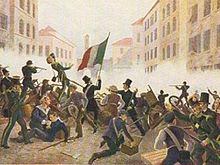
On 18 March 1848 Milan effectively rebelled against Austrian rule, during the so-called "Five Days" (Italian: Le Cinque Giornate), that forced Field Marshal Radetzky to temporarily withdraw from the city. The bordering Kingdom of Piedmont–Sardinia sent troops to protect the insurgents and organised a plebiscite that ratified by a huge majority the unification of Lombardy with Piedmont–Sardinia. But just a few months later the Austrians were able to send fresh forces that routed the Piedmontese army at the Battle of Custoza on 24 July and to reassert Austrian control over northern Italy. About ten years later, however, Italian nationalist politicians, officers and intellectuals such as Cavour, Garibaldi and Mazzini were able to gather a huge consensus and to pressure the monarchy to forge an alliance with the new French Empire of Napoleon III to defeat Austria and establish a large Italian state in the region. At the Battle of Solferino in 1859 French and Italian troops heavily defeated the Austrians that retreated under the Quadrilateral line.[73] Following this battle, Milan and the rest of Lombardy were incorporated into Piedmont-Sardinia, which then proceeded to annex all the other Italian statelets and proclaim the birth of the Kingdom of Italy on 17 March 1861.
The political unification of Italy enhanced Milan's economic dominance over northern Italy. A dense rail network, whose construction had started under Austrian patronage, was completed in a brief time, making Milan the rail hub of northern Italy and, with the opening of the Gotthard (1882) and Simplon (1906) railway tunnels, the major South European rail hub for goods and passenger transport. Indeed, Milan and Venice were among the main stops of the Orient Express that started operating from 1919.[74] Abundant hydroelectric resources allowed the development of a strong steel and textile sector and, as Milanese banks dominated Italy's financial sphere, the city became the country's leading financial centre. In May 1898, Milan was shaken by the Bava Beccaris massacre, a riot related to soaring cost of living.[75]
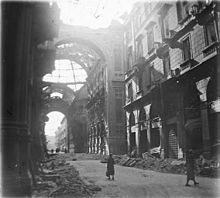
Milan's northern location in Italy closer to Europe, secured also a leading role for the city on the political scene. It was in Milan that Benito Mussolini built his political and journalistic careers, and his fascist Blackshirts rallied for the first time in the city's Piazza San Sepolcro; here the future Fascist dictator launched his March on Rome on 28 October 1922. During the Second World War Milan's large industrial and transport facilities suffered extensive damage from Allied bombings that often also hit residential districts.[76] When Italy surrendered in 1943, German forces occupied and plundered most of northern Italy, fueling the birth of a massive resistance guerrilla movement.[77] On 29 April 1945, the American 1st Armored Division was advancing on Milan but, before it arrived, the Italian resistance seized control of the city and executed Mussolini along with his mistress and several regime officers, that were later hanged and exposed in Piazzale Loreto, where one year before some resistance members had been executed.
During the post-war economic boom, the reconstruction effort and the Italian economic miracle attracted a large wave of internal migration (especially from rural areas of southern Italy) to Milan. The population grew from 1.3 million in 1951 to 1.7 million in 1967.[78] During this period, Milan was rapidly rebuilt, with the construction of several innovative and modernist skyscrapers, such as the Torre Velasca and the Pirelli Tower, that soon became the symbols of this new era of prosperity.[79] The economic prosperity was, however, overshadowed in the late 1960s and early 1970s during the so-called Years of lead, when Milan witnessed an unprecedented wave of street violence, labour strikes and political terrorism. The apex of this period of turmoil occurred on 12 December 1969, when a bomb exploded at the National Agrarian Bank in Piazza Fontana, killing 17 people and injuring 88.

In the 1980s, with the international success of Milanese houses (like Armani, Prada, Versace, Moschino and Dolce & Gabbana), Milan became one of the world's fashion capitals. The city saw also a marked rise in international tourism, notably from America and Japan, while the stock exchange increased its market capitalisation more than five-fold.[80] This period led the mass media to nickname the metropolis "Milano da bere", literally "Milan to be drunk".[81] But in the 1990s Milan was badly affected by Tangentopoli, a political scandal in which many politicians and businessmen were tried for corruption. The city was also affected by a severe financial crisis and a steady decline in textiles, automobile and steel production.[79] Berlusconi's Milano 2 and Milano 3 projects were the most important housing projects of the 1980s and 1990s in Milan and brought to the city new economical and social energy.
In the early 21st century Milan underwent a series of sweeping redevelopments over huge former industrial areas.[82] Two new business districts, Porta Nuova and CityLife, were built in the space of a decade, radically changing the skyline of the city. Its exhibition centre moved to a much larger site in Rho.[83] The long decline in traditional manufacturing has been overshadowed by a great expansion of publishing, finance, banking, fashion design, information technology, logistics and tourism.[84] The city's decades-long population decline seems to have partially reverted in recent years, as the comune gained about 100,000 new residents since the last census. The successful re-branding of the city as a global capital of innovation has been instrumental in its successful bids for hosting large international events such as 2015 Expo and 2026 Winter Olympics.
Geography
[edit]Topography
[edit]
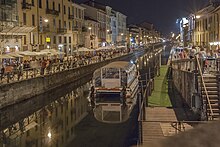
Milan is located in the north-western section of the Po Valley, approximately halfway between the river Po to the south and the foothills of the Alps with the great lakes (Lake Como, Lake Maggiore and Lake Lugano) to the north, the Ticino river to the west and the Adda to the east. The city's land is flat, the highest point being at 122 m (400.26 ft) above sea level.
The administrative comune covers an area of about 181 square kilometres (70 sq mi), with a population, in 2013, of 1,324,169 and a population density of 7,315 inhabitants per square kilometre (18,950/sq mi). The Metropolitan City of Milan covers 1,575 square kilometres (608 sq mi) and in 2015 had a population estimated at 3,196,825, with a resulting density of 2,029 inhabitants per square kilometre (5,260/sq mi).[85] A larger urban area, comprising parts of the provinces of Milan, Monza e Brianza, Como, Lecco and Varese is 1,891 square kilometres (730 sq mi) wide and has a population of 5.27 million with a density of 2,783 inhabitants per square kilometre (7,210/sq mi).[10]
The concentric layout of the city centre reflects the Navigli, an ancient system of navigable and interconnected canals, now mostly covered.[86] The suburbs of the city have expanded mainly to the north, swallowing up many comuni along the roads towards Varese, Como, Lecco and Bergamo.[87] In the 21st century the Navigli region of Milan is a highly active area with a large number of residential units, bars and restaurants. It is also a well-known centre for artists.[88]
Climate
[edit]
Milan features a mid-latitude, four-season humid subtropical climate (Cfa), according to the Köppen climate classification. Milan's climate is similar to much of Northern Italy's inland plains, with hot, humid summers and cold, foggy winters. The Alps and Apennine Mountains form a natural barrier that protects the city from the major circulations coming from northern Europe and the sea.[89]
During winter daily average temperatures can fall below freezing (0 °C [32 °F]) and accumulations of snow can occur: the historic average of Milan's area is 25 centimetres (10 in) in the period between 1961 and 1990, with a record of 90 centimetres (35 in) in January 1985. In the suburbs the average can reach 36 centimetres (14 in).[90] The city receives on average seven days of snow per year.[91]
The city was often shrouded in thick cloud or fog during winter, although the removal of rice paddies from the southern neighbourhoods and the urban heat island effect have greatly reduced this occurrence since the turn of the 21st century. Occasionally, the Foehn winds cause the temperatures to rise unexpectedly: on 22 January 2012 the daily high reached 16 °C (61 °F) while on 22 February 2012 it reached 21 °C (70 °F).[92] Air pollution levels rise significantly in wintertime when cold air clings to the soil, causing Milan to be one of Europe's most polluted cities.[93][94]

Summers in Milan are hot and humidity levels are high with peak temperatures reaching above 35 °C (95 °F). Due to the high humidity, urban heat effect and lack of wind, nighttimes often remain muggy during the summer months.[95] Usually the summer enjoys clearer skies with an average of more than 13 hours of daylight:[96] when precipitation occurs though, it is more likely to be accompanied by thunderstorms and hail.[96] Springs and autumns are generally pleasant, with temperatures ranging between 10 and 20 °C (50 and 68 °F); these seasons are characterized by higher rainfall, especially in April and May.[97] Relative humidity typically ranges between 45% (comfortable) and 95% (very humid) throughout the year, rarely dropping below 27% (dry) and reaching as high as 100%.[96] Wind is generally absent: over the course of the year typical wind speeds vary from 0 to 14 km/h (0 to 9 mph) (calm to gentle breeze), rarely exceeding 29 km/h (18 mph) (fresh breeze), except during summer thunderstorms when winds can blow strong. In the spring, gale-force windstorms may happen, generated either by Tramontane blowing from the Alps or by Bora-like winds from the north. Due to its geographic location surrounded by mountains on 3 sides, Milan is among the least windy cities in Europe.[96]
| Climate data for Linate Airport, Milan (1991–2020 normals, sun 1981-2010, extremes 1946–present) | |||||||||||||
|---|---|---|---|---|---|---|---|---|---|---|---|---|---|
| Month | Jan | Feb | Mar | Apr | May | Jun | Jul | Aug | Sep | Oct | Nov | Dec | Year |
| Record high °C (°F) | 21.7 (71.1) |
23.8 (74.8) |
26.9 (80.4) |
32.4 (90.3) |
35.5 (95.9) |
36.6 (97.9) |
37.2 (99.0) |
39.3 (102.7) |
33.2 (91.8) |
28.2 (82.8) |
25.5 (77.9) |
24.5 (76.1) |
39.3 (102.7) |
| Mean daily maximum °C (°F) | 7.3 (45.1) |
10.0 (50.0) |
15.5 (59.9) |
19.3 (66.7) |
23.9 (75.0) |
28.1 (82.6) |
30.7 (87.3) |
29.9 (85.8) |
25.5 (77.9) |
19.0 (66.2) |
12.4 (54.3) |
7.4 (45.3) |
19.1 (66.3) |
| Daily mean °C (°F) | 3.2 (37.8) |
5.2 (41.4) |
9.9 (49.8) |
13.8 (56.8) |
18.5 (65.3) |
22.7 (72.9) |
25.1 (77.2) |
24.4 (75.9) |
19.9 (67.8) |
14.4 (57.9) |
8.7 (47.7) |
3.9 (39.0) |
14.1 (57.5) |
| Mean daily minimum °C (°F) | −0.4 (31.3) |
0.6 (33.1) |
4.4 (39.9) |
8.4 (47.1) |
12.8 (55.0) |
17.2 (63.0) |
19.3 (66.7) |
18.8 (65.8) |
14.9 (58.8) |
10.2 (50.4) |
5.3 (41.5) |
0.6 (33.1) |
9.3 (48.8) |
| Record low °C (°F) | −15.0 (5.0) |
−15.6 (3.9) |
−7.4 (18.7) |
−2.5 (27.5) |
−0.8 (30.6) |
5.6 (42.1) |
8.4 (47.1) |
8.0 (46.4) |
3.0 (37.4) |
−2.3 (27.9) |
−6.2 (20.8) |
−13.6 (7.5) |
−15.6 (3.9) |
| Average precipitation mm (inches) | 35.9 (1.41) |
38.2 (1.50) |
42.2 (1.66) |
57.7 (2.27) |
70.3 (2.77) |
67.4 (2.65) |
44.2 (1.74) |
82.2 (3.24) |
73.4 (2.89) |
82.0 (3.23) |
112.4 (4.43) |
45.8 (1.80) |
751.7 (29.59) |
| Average precipitation days (≥ 1.0 mm) | 4.7 | 4.5 | 5.4 | 7.2 | 8.4 | 6.6 | 4.5 | 5.5 | 5.1 | 6.6 | 8.3 | 5.7 | 72.5 |
| Average relative humidity (%) | 78.9 | 73.6 | 68.0 | 67.7 | 67.2 | 66.9 | 66.2 | 67.4 | 70.0 | 76.5 | 81.0 | 81.8 | 72.1 |
| Average dew point °C (°F) | 0.2 (32.4) |
0.8 (33.4) |
3.9 (39.0) |
7.0 (44.6) |
11.2 (52.2) |
14.7 (58.5) |
16.6 (61.9) |
16.8 (62.2) |
13.4 (56.1) |
10.1 (50.2) |
5.9 (42.6) |
1.2 (34.2) |
8.5 (47.3) |
| Mean monthly sunshine hours | 91.4 | 108.5 | 170.0 | 178.4 | 212.3 | 247.6 | 293.2 | 237.6 | 179.3 | 116.5 | 73.3 | 67.1 | 1,975.2 |
| Source 1: NOAA NCEI[98][99] | |||||||||||||
| Source 2: Istituto Superiore per la Protezione e la Ricerca Ambientale[100] | |||||||||||||
| Climate data for Malpensa Airport, Milan (1961–1990 normals, extremes 1951–present) | |||||||||||||
|---|---|---|---|---|---|---|---|---|---|---|---|---|---|
| Month | Jan | Feb | Mar | Apr | May | Jun | Jul | Aug | Sep | Oct | Nov | Dec | Year |
| Record high °C (°F) | 22.4 (72.3) |
24.4 (75.9) |
28.9 (84.0) |
31.6 (88.9) |
35.1 (95.2) |
37.6 (99.7) |
38.2 (100.8) |
38.8 (101.8) |
33.9 (93.0) |
29.8 (85.6) |
22.8 (73.0) |
20.8 (69.4) |
38.8 (101.8) |
| Mean daily maximum °C (°F) | 6.1 (43.0) |
8.6 (47.5) |
13.1 (55.6) |
17.0 (62.6) |
21.3 (70.3) |
25.5 (77.9) |
28.6 (83.5) |
27.6 (81.7) |
24.0 (75.2) |
18.2 (64.8) |
11.2 (52.2) |
6.9 (44.4) |
17.3 (63.2) |
| Daily mean °C (°F) | 0.9 (33.6) |
3.1 (37.6) |
6.8 (44.2) |
10.7 (51.3) |
15.2 (59.4) |
19.1 (66.4) |
22.0 (71.6) |
21.2 (70.2) |
17.8 (64.0) |
12.3 (54.1) |
6.0 (42.8) |
1.7 (35.1) |
11.4 (52.5) |
| Mean daily minimum °C (°F) | −4.4 (24.1) |
−2.5 (27.5) |
0.4 (32.7) |
4.3 (39.7) |
9.0 (48.2) |
12.6 (54.7) |
15.3 (59.5) |
14.8 (58.6) |
11.5 (52.7) |
6.4 (43.5) |
0.7 (33.3) |
−3.6 (25.5) |
5.4 (41.7) |
| Record low °C (°F) | −18.0 (−0.4) |
−17.8 (0.0) |
−12.2 (10.0) |
−9.0 (15.8) |
−5.2 (22.6) |
0.6 (33.1) |
4.7 (40.5) |
3.0 (37.4) |
0.5 (32.9) |
−6.2 (20.8) |
−13.6 (7.5) |
−15.2 (4.6) |
−18.0 (−0.4) |
| Average precipitation mm (inches) | 67.5 (2.66) |
77.1 (3.04) |
99.7 (3.93) |
106.3 (4.19) |
132.0 (5.20) |
93.3 (3.67) |
66.8 (2.63) |
97.5 (3.84) |
73.2 (2.88) |
107.4 (4.23) |
106.3 (4.19) |
54.6 (2.15) |
1,081.7 (42.61) |
| Average precipitation days (≥ 1.0 mm) | 6.4 | 6.1 | 7.6 | 8.8 | 10.4 | 8.5 | 6.1 | 7.5 | 5.7 | 6.7 | 7.9 | 5.5 | 87.2 |
| Average relative humidity (%) | 78 | 76 | 69 | 73 | 74 | 74 | 74 | 73 | 74 | 77 | 80 | 80 | 75 |
| Source 1: NOAA[101] | |||||||||||||
| Source 2: KNMI[102] | |||||||||||||
Administration
[edit]Municipal government
[edit]
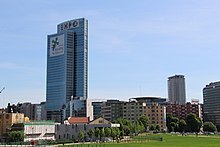

The legislative body of the Italian comuni is the City Council (Consiglio Comunale), which in cities with more than one million population is composed by 48 councillors elected every five years with a proportional system, at the same time of the mayoral elections. The executive body is the City Committee (Giunta Comunale), composed by 12 assessors, that is nominated and presided over by a directly elected Mayor. The current mayor of Milan is Giuseppe Sala, an independent leading a centre-left alliance led by the Democratic Party.
The municipality of Milan is subdivided into nine administrative Borough Councils (Consigli di Municipio), down from the former twenty districts before the 1999 administrative reform.[103] Each Borough Council is governed by a Council (Consiglio) and a President, elected contextually to the city Mayor. The urban organisation is governed by the Italian Constitution (art. 114), the Municipal Statute[104] and several laws, notably the Legislative Decree 267/2000 or Unified Text on Local Administration (Testo Unico degli Enti Locali).[105] After the 2016 administrative reform, the Borough Councils have the power to advise the Mayor with nonbinding opinions on a large spectrum of topics and are responsible for running most local services, such as schools, social services, waste collection, roads, parks, libraries and local commerce; in addition they are supplied with an autonomous funding to finance local activities.
Metropolitan city
[edit]
Milan is the capital of the eponymous Metropolitan city. According to the last governmental dispositions concerning administrative reorganisation, the urban area of Milan is one of the 15 Metropolitan municipalities (città metropolitane), new administrative bodies fully operative since 1 January 2015.[106] The new Metro municipalities, giving large urban areas the administrative powers of a province, are conceived for improving the performance of local administrations and to slash local spending by better co-ordinating the municipalities in providing basic services (including transport, school and social programs) and environment protection.[107] In this policy framework, the Mayor of Milan is designated to exercise the functions of Metropolitan mayor (Sindaco metropolitano), presiding over a Metropolitan Council formed by 24 mayors of municipalities within the Metro municipality. The Metropolitan City of Milan is headed by the Metropolitan Mayor (Sindaco metropolitano) and by the Metropolitan Council (Consiglio metropolitano). Since 21 June 2016, Giuseppe Sala, as mayor of the capital city, has been the mayor of the Metropolitan City.
Regional government
[edit]Milan is also the capital of Lombardy, one of the twenty regions of Italy. Lombardy is by far the most populated region of Italy, with more than ten million inhabitants, almost one sixth of the national total. It is governed by a Regional Council, composed of 80 members elected for a five-year term. On 26 March 2018, a list of candidates of the centre-right coalition, a coalition of centrist and right-wing parties, led by Attilio Fontana, largely won the regional election, defeating a coalition of socialists, liberals and ecologists and a third-party candidate from the populist Five Stars Movement. The conservatives have governed the region almost uninterruptedly since 1970. The regional council has 48 members from the centre-right coalition, 18 from the centre-left coalition and 13 from the Five Star Movement. The seat of the regional government is Palazzo Lombardia that, standing at 161.3 metres (529 feet),[108] is the fifth-tallest building in Milan.
Cityscape
[edit]Skyline
[edit]Architecture
[edit]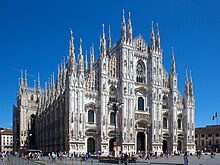
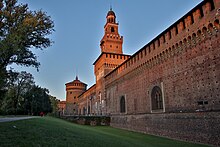
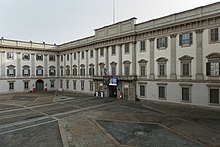
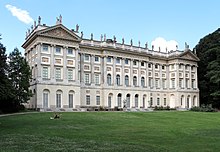


The architectural and artistic presence in Milan represents one of the attractions of the Lombard capital. Milan has been among the most important Italian centers in the history of architecture, has made important contributions to the development of art history, and has been the cradle of a number of modern art movements.
There are only few remains of the ancient Roman city, notably the well-preserved Colonne di San Lorenzo. During the second half of the 4th century, Saint Ambrose, as bishop of Milan, had a strong influence on the layout of the city, reshaping the centre (although the cathedral and baptistery built in Roman times are now lost) and building the great basilicas at the city gates: Sant'Ambrogio, San Nazaro in Brolo, San Simpliciano and Sant'Eustorgio, which still stand, refurbished over the centuries, as some of the finest and most important churches in Milan. Milan's Cathedral, built between 1386 and 1877, is the largest church in the Italian Republic—the larger St. Peter's Basilica is in the State of Vatican City, a sovereign state—and the third largest in the world,[109] as well as the most important example of Gothic architecture in Italy. The gilt bronze statue of the Virgin Mary, placed in 1774 on the highest pinnacle of the Duomo, soon became one of the most enduring symbols of Milan.[110]
In the 15th century, when the Sforza ruled the city, an old Viscontean fortress was enlarged and embellished to become the Castello Sforzesco, the seat of an elegant Renaissance court surrounded by a walled hunting park. Notable architects involved in the project included the Florentine Filarete, who was commissioned to build the high central entrance tower, and the military specialist Bartolomeo Gadio.[111] The alliance between Francesco Sforza and Florence's Cosimo de' Medici bore to Milan Tuscan models of Renaissance architecture, apparent in the Ospedale Maggiore and Bramante's work in the city, which includes Santa Maria presso San Satiro (a reconstruction of a small 9th-century church), the tribune of Santa Maria delle Grazie and three cloisters for Sant'Ambrogio.[112] The Counter-Reformation in the 16th to 17th centuries was also the period of Spanish domination and was marked by two powerful figures: Saint Charles Borromeo and his cousin, Cardinal Federico Borromeo. Not only did they impose themselves as moral guides to the people of Milan, but they also gave a great impulse to culture, with the creation of the Biblioteca Ambrosiana, in a building designed by Francesco Maria Richini, and the nearby Pinacoteca Ambrosiana. Many notable churches and Baroque mansions were built in the city during this period by the architects, Pellegrino Tibaldi, Galeazzo Alessi and Richini himself.[113]
Empress Maria Theresa of Austria was responsible for the significant renovations carried out in Milan during the 18th century.[114] This urban and artistic renewal included the establishment of Teatro alla Scala, inaugurated in 1778, and the renovation of the Royal Palace. The late 1700s Palazzo Belgioioso by Giuseppe Piermarini and Royal Villa of Milan by Leopoldo Pollack, later the official residence of Austrian viceroys, are often regarded among the best examples of Neoclassical architecture in Lombardy.[115] The Napoleonic rule of the city in 1805–1814, having established Milan as the capital of a satellite Kingdom of Italy, took steps to reshape it accordingly to its new status, with the construction of large boulevards, new squares (Porta Ticinese by Luigi Cagnola and Foro Bonaparte by Giovanni Antonio Antolini) and cultural institutions (Art Gallery and the Academy of Fine Arts).[116] The massive Arch of Peace, situated at the bottom of Corso Sempione, is often compared to the Arc de Triomphe in Paris. In the second half of the 19th century, Milan quickly became the main industrial centre of the new Italian nation, drawing inspiration from the great European capitals that were hubs of the Second Industrial Revolution. The great Galleria Vittorio Emanuele II, realised by Giuseppe Mengoni between 1865 and 1877 to celebrate Vittorio Emanuele II, is a covered passage with a glass and cast iron roof, inspired by the Burlington Arcade in London. Several other arcades such as the Galleria del Corso, built between 1923 and 1931, complement it. Another late-19th-century eclectic monument in the city is the Cimitero Monumentale graveyard, built in a Neo-Romanesque style between 1863 and 1866.
The tumultuous period of early 20th century brought several, radical innovations in Milanese architecture. Art Nouveau, also known as Liberty in Italy, is recognisable in Palazzo Castiglioni, built by architect Giuseppe Sommaruga between 1901 and 1903.[117] Other examples include Hotel Corso,[117] Casa Guazzoni with its wrought iron and staircase, and Berri-Meregalli house, the latter built in a traditional Milanese Art Nouveau style combined with elements of neo-Romanesque and Gothic revival architecture, regarded as one of the last such types of architecture in the city.[118] A new, more eclectic form of architecture can be seen in buildings such as Castello Cova, built the 1910s in a distinctly neo-medieval style, evoking the architectural trends of the past.[119] An important example of Art Deco, which blended such styles with Fascist architecture, is the huge Central railway station inaugurated in 1931.[120]
The post-World War II period saw rapid reconstruction and fast economic growth, accompanied by a nearly two-fold increase in population. In the 1950s and 1960s, a strong demand for new residential and commercial areas drove to extreme urban expansion, that has produced some of the major milestones in the city's architectural history, including Gio Ponti's Pirelli Tower (1956–60), Velasca Tower (1956–58), and the creation of brand new residential satellite towns, as well as huge amounts of low-quality public housings. In recent years, de-industrialization, urban decay and gentrification led to a vast urban renewal of former industrial areas, that have been transformed into modern residential and financial districts, notably Porta Nuova in downtown Milan and FieraMilano in the suburb of Rho. In addition, the old exhibition area is being completely reshaped according to the Citylife regeneration project, featuring residencial areas, museums, an urban park and three skyscrapers designed by international architects, and after whom they are named: the 202-metre (663-foot) Isozaki Arata—when completed, the tallest building in Italy,[121] the twisted Hadid Tower,[122] and the curved Libeskind Tower.[123]
Two business districts dominate Milan's skyline: Porta Nuova in the north-east (boroughs No. 9 and 2) and CityLife (borough No. 8) in the north-west part of the commune. The tallest buildings include the Unicredit Tower at 231 m (though only 162 m without the spire), and the 209 m Allianz Tower, a 50-story tower.
Parks and gardens
[edit]
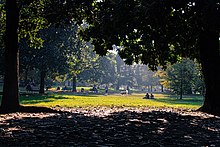

The largest parks in the central area of Milan are Sempione Park, at the north-western edge, and Montanelli Gardens, situated north-east of the city. English-style Sempione Park, built in 1890, contains the Civic Arena, the Civic Aquarium of Milan (which is the third oldest aquarium in Europe[124]), a steel lattice panoramic tower, an art exhibition centre, a Japanese garden and a public library.[125] The Montanelli gardens, created in the 18th century, hosts the Natural History Museum of Milan and a planetarium.[126] Slightly away from the city centre, heading east, Forlanini Park is characterised by a large pond and a few preserved shacks which remind of the area's agricultural past.[127] In recent years Milan's authorities pledged to develop its green areas: they planned to create twenty new urban parks and extend the already existing ones, and announced plans to plant three million trees by 2030.[citation needed]
Also notable is Monte Stella ("Starmount"), also informally called Montagnetta di San Siro ("Little mountain of San Siro"), an artificial hill and surrounding city park in Milan. The hill was created using the debris from the buildings that were bombed during World War II, as well as from the last remnants of the Spanish walls of the city, demolished in the mid 20th century. Even at only 25 m (82 ft) height, the hill provides a panoramic view of the city and hinterland, and in a clear day, the Alps and Apennines can be distinguished from atop. A notable area of the park is called "Giardino dei Giusti" (Garden of the Just), which is a memorial to distinguished opponents of genocide and crimes against humanity; each tree in the garden is dedicated to one such person. Notable people who have been dedicated a tree in the Giardino dei Giusti include Moshe Bejski, Andrej Sakharov, Svetlana Broz, and Pietro Kuciukian.
The Orto Botanico di Brera a botanical garden located behind Palazzo Brera at Via Brera 28 in the center of Milan, is another major park in the city. The garden consists primarily of rectangular flower-beds, trimmed in brick, with elliptical ponds from the 18th century, and specula and greenhouse from the 19th century (now used by the Academy of Fine Arts). It contains one of the oldest Ginkgo biloba trees in Europe, as well as mature specimens of Firmiana platanifolia, Juglans nigra, Pterocarya fraxinifolia, and Tilia.
In addition, even though Milan is located in one of the most urbanised regions of Italy, it is surrounded by a belt of green areas and features numerous gardens even in its very centre. The farmlands and woodlands north (Parco Nord Milano since 1975) and south (Parco Agricolo Sud Milano since 1990) of the urban area have been protected as regional parks.[128][129] West of the city, the Parco delle Cave (Sand pit park) has been established on a neglected site where gravel and sand used to be extracted, featuring artificial lakes and woods.[130]
Demographics
[edit]| Year | Pop. | ±% |
|---|---|---|
| 1861 | 267,621 | — |
| 1871 | 290,518 | +8.6% |
| 1881 | 354,045 | +21.9% |
| 1901 | 538,483 | +52.1% |
| 1911 | 701,411 | +30.3% |
| 1921 | 818,161 | +16.6% |
| 1931 | 960,682 | +17.4% |
| 1936 | 1,115,794 | +16.1% |
| 1951 | 1,274,187 | +14.2% |
| 1961 | 1,582,474 | +24.2% |
| 1971 | 1,732,068 | +9.5% |
| 1981 | 1,604,844 | −7.3% |
| 1991 | 1,369,295 | −14.7% |
| 2001 | 1,256,211 | −8.3% |
| 2011 | 1,242,123 | −1.1% |
| 2021 | 1,371,498 | +10.4% |
| Istat historical data 1861–2021[131] | ||
The official estimated population of the City of Milan was 1,417,597 as of 31 December 2023, according to the municipality's statistical office.[132]
Mid-2024 estimates suggest that 3,251,166 people lived in Milan province-level municipality.[133] The population of Milan today is lower than its historical peak. With rapid industrialization in post-war years, the population of Milan peaked at 1,743,427 in 1973.[134] Thereafter, during the following decades, about one third of the population moved to the outer belt of suburbs and new satellite settlements that grew around the city proper.
Today, Milan's conurbation extends well beyond the borders of the city proper and of its special-status provincial authority: its contiguous built-up urban area was home to 5.27 million people in 2015,[10] while its wider metropolitan area, the largest in Italy and fourth largest in the EU, is estimated to have a population of more than 8.2 million.[12]
Foreign residents
[edit]Nationality held by residents as of 2023[135]
| Country of foreign nationality | Population |
|---|---|
| 45,457 | |
| 38,942 | |
| 37,041 | |
| 17,799 | |
| 16,724 | |
| 15,673 | |
| 12,802 | |
| 9,704 | |
| 9,513 | |
| 8,351 | |
| 6,363 | |
| 4,961 | |
| 4,862 | |
| 3,493 | |
| 3,407 | |
| 3,372 | |
| 3,121 | |
| 2,955 | |
| 2,746 | |
| 2,340 | |
| 2,310 | |
| 2,189 | |
| 2,186 | |
| 2,133 | |
| 2,098 | |
| 2,006 | |
| 1,976 | |
| 1,767 | |
| 1,627 | |
| 1,617 | |
| 1,529 | |
| 1,311 | |
| 1,275 | |
| 1,089 | |
| 1,044 | |
| 1,014 | |
| other countries | each <1000 |
As of 2023, some 301,149 foreign residents lived in the municipality of Milan, representing 21.2% of the total resident population.[136] These figures suggest that the immigrant population has more than doubled in the last 15 years.[137]
After World War II, Milan experienced two main waves of immigration: the first, dating from the 1950s to the early 1970s, saw a large influx of migrants from poorer and rural areas within Italy; the second, starting from the late 1980s, has been characterized by the preponderance of foreign-born immigrants.[138]
The early period coincided with the so-called Italian economic miracle of postwar years, an era of extraordinary growth based on rapid industrial expansion and great public works, that brought to the city a large influx of over 400,000 people, mainly from rural and underdeveloped Southern Italy.[79]

Decades of continuing high immigration have made the city one of the most cosmopolitan and multicultural in Italy. Immigrants came mainly from Africa (in particular Eritreans, Egyptians, Moroccans, Senegalese and Nigerian), and the former socialist countries of Eastern Europe (notably Albanians, Romanians, Ukrainians, Macedonians, Moldovans, and Russians), in addition to a growing number of Asians (in particular Chinese, Sri Lankans and Filipinos) and Latin Americans (Mainly South Americans). At the beginning of the 1990s, Milan already had a population of foreign-born residents of approximately 58,000 (or 4% of the then population), that rose rapidly to over 117,000 by the end of the decade (about 9% of the total).[139]

Milan is home to the second-largest Far East Asian community in Europe after Paris, with the Philippines and China, making up about a quarter of its foreign population (around 76,000 out of 301,000 in 2023). Another 4,000 foreigners come from other East Asian countries; notably, Milan hosts more than 2,000 Japanese nationals and 1,000 Koreans, excluding those who also hold Italian citizenship.[140][136] Foreigners holding East-Asian citizenship thus make up around 5.36% of the city's population. Milan notably hosts the oldest and largest (along with Prato) Chinese community in Italy, with around 37,000 people in 2023, excluding Italians of Chinese descent such as immigrants who have acquired Italian citizenship or their descendants. Situated in the 8th district, and centered on Via Paolo Sarpi, an important commercial avenue, the Milanese Chinatown was originally established in the 1920s by immigrants from Wencheng County, in the Zhejiang, and used to operate small textile and leather workshops.[141] Milan also hosts a Japanese International school as well as various Chinese schools throughout the city.[142][143]

The city also hosts an historical African community originating from the Horn of Africa. As of 2023, there were around 4,000 Eritrean, Ethiopian or Somali-born people living in Milan, the overwhelming majority being double-citizens of Italy. and not counting second and third generation migrants. The three countries were all Italian colonies at a time, from 1869 (Eritrea) [144][145][146] to 1943 (East African campaign). Due to the historical links with Italy, a small community originating from the Horn of Africa has established its presence near Porta Venezia district starting from the 1970s.[147][148][149][150] It is estimated that in the "Asmarina" area (Little Asmara) there are around 2,000-2,500 people from the Horn of Africa still living there, along with multiple restaurants, institutes as well as an Ethiopian Church.[151][152][153]
Another notable area with a large presence of foreign residents coming from a specific country is the so-called "quadrilatero di San Siro" or "San Siro casbah" in reference to the large Arab-speaking populaition living in the area.[154][155][156][157] The neighbourhood, consisting of around 6,000 municipal flats, is characterised by the fact of having an estimated 25% share of Arab-speaking inhabitants, mostly hailing from Egypt.[158][159][160] The area has often been described as a banlieue within Milan and has historically had a higher crime rate than the rest of the city. Nevertheless, in recent years many projects have been presented so as to mitigate the marginalisation of its inhabitants. Other areas hosting large Arabic-speaking populations include Maciachini-Imbonati, Corvetto, Comasina and piazza Arcole.[161][162][163][164][165][166]
Milan has also a substantial English-speaking community (around 4,500 US citizens, British, Irish and Australian expatriates, excluding double-citizens), and several English schools and English-language publications, such as Hello Milano, Where Milano and Easy Milano.[136]
Religion
[edit]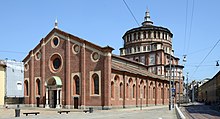

Milan's population, like that of Italy as a whole, is mostly Catholic.[167][168] It is the seat of the Archdiocese of Milan. Greater Milan is also home to Protestant, Eastern Orthodox, Jewish, Muslim, Hindu, Sikh and Buddhist communities.[169][170][171][172][173]
Milan has been a Christian-majority city since the late Roman Empire.[174] Its religious history was marked by the figure of St. Ambrose, whose heritage includes the Ambrosian Rite (Italian: Rito ambrosiano), used by some five million Catholics in the greater part of the Archdiocese of Milan,[175] which consider the largest in Europe.[176] The Rite varies slightly from the canonical Roman Rite liturgy, with differences in the mass, liturgical year (Lent starts four days later than in the Roman Rite), baptism, rite of funerals, priest clothes and sacred music (use of the Ambrosian chant rather than Gregorian).[177]
In addition, the city is home to the largest Orthodox community in Italy. Lombardy is the seat of at least 78 Orthodox parishes and monasteries, the vast majority of them located in the area of Milan.[178] The main Romanian Orthodox church in Milan is the Catholic church of Our Lady of Victory (Chiesa di Santa Maria della Vittoria), currently granted for use to the local Romanian community.[179] Similarly, the point of reference for the followers of the Russian Orthodox Church is the Catholic church of San Vito in Pasquirolo.[180][181]
The Jewish community of Milan is the second largest in Italy after Rome, with about 10,000 members, mainly Sephardi.[182] The main city synagogue, Hechal David u-Mordechai Temple, was built by architect Luca Beltrami in 1892 and is also the community's main headquarters, is located in Via della Guastalla. The interior was renovated in 1997.
Milan hosts also one of the largest Muslim communities in Italy,[183] and the city saw the construction of the country's first new mosque featuring a dome and minaret, since the destruction of the ancient mosques of Lucera in the year 1300. In 2014 the City Council agreed on the construction of a new mosque amid bitter political debate, since it is strenuously opposed by right-wing parties such as the Northern League.[184] As of 2018, the Muslim population is estimated at 9% of the city's population.[185]
Currently, accurate statistics on the Hindu and Sikh presence in Milan metro area are not available; however, various sources estimate that about 40% of the total Indian population living in Italy, or about 50,000 individuals, reside in Lombardy,[186][187] where a number of Hindu and Sikh temples exist and where they form the largest such communities in Europe after the ones in Britain.[188]
Economy
[edit]

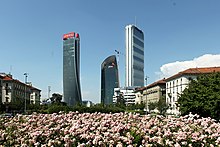

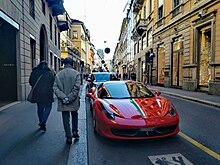
Milan is the economic capital of Italy[13] and is a global financial centre. Milan is, together with London, Hamburg, Frankfurt, Munich and Paris, one of the six European economic capitals.[14] Milan is the capital of the Lombardy region in northern Italy and is the wealthiest city in Italy.[191] Milan and Lombardy had a GDP of €400 billion ($493 billion) and €650 billion ($801 billion), respectively, in 2017.[192] It is a member of the Blue Banana corridor and of the Four Motors for Europe among Europe's economic leaders. Milan's hinterland is Italy's largest industrial area. Milan's GDP per capita of about €49,500 (US$55,600) ranks among Italy's highest.[193]
Whereas Rome is Italy's political and cultural capital, Milan is the country's industrial and financial heart. With a 2019 GDP estimated at €207.4 billion,[194] the province of Milan generates approximately 10% of the national GDP; while the economy of the Lombardy region generates approximately 19.5% of Italy's GDP (or an estimated €400 billion in 2021,[195] roughly the size of Belgium). The province of Milan is home to about 45% of businesses in the Lombardy region and more than 8 percent of all businesses in Italy, including three Fortune 500 companies.[196]
According to the Economist Intelligence Unit, Milan was the 11th-most-expensive city in Europe and the 22nd-most-expensive city in the world in 2019,[197] while the well-known Via Monte Napoleone is Europe's most expensive street and the second-most-expensive street in the world after Fifth Avenue in New York City (2023).[190]
Since the late 1800s, the area of Milan has been a major industrial and manufacturing centre. Alfa Romeo automobile company and Falck steel group employed thousands of workers in the city until the closure of their sites in Arese in 2004 and Sesto San Giovanni in 1995. Other global industrial companies, such as Edison, Prysmian Group, Riva Group, Saras, Saipem and Techint, maintain their headquarters and significant employment in the city and its suburbs. Other relevant industries active in metro Milan include chemicals (e.g. Mapei, Versalis, Tamoil Italy), home appliances (e.g. Candy), hospitality (UNA Hotels & Resorts), food & beverages (e.g. Bertolli, Campari), machinery, medical technologies (e.g. Amplifon, Bracco), plastics and textiles. The construction (e.g. Webuild), retail (e.g. Esselunga, La Rinascente) and utilities (e.g. A2A, Edison S.p.A., Snam, Sorgenia) sectors are also large employers in the Greater Milan.
Milan is Italy's largest financial hub. The main national insurance companies and banking groups (for a total of 198 companies) and over forty foreign insurance and banking companies are located in the city,[198] as well as a number of asset management companies, including Anima Holding, Azimut Holding, ARCA SGR and Eurizon Capital. The Associazione Bancaria Italiana representing the Italian banking system, and Milan Stock Exchange (225 companies listed on the stock exchange) are both located in the city. Porta Nuova, the main business district of Milan and one of the most important in Europe, hosts the Italian headquarters of numerous global companies, such as Accenture, AXA, Bank of America, BNP Paribas, Celgene, China Construction Bank, Deutsche Bank, FM Global, Herbalife, Amazon, Iliad, KPMG, Maire Tecnimont, Mitsubishi UFJ Financial Group, Panasonic, Pirelli, Ubisoft, Shire, Tata Consultancy Services, Telecom Italia, UniCredit, UnipolSai.
Other large multinational service companies, such as Allianz, Generali, Alleanza Assicurazioni and PricewaterhouseCoopers, have their headquarters in the CityLife business district, a new 900-acre-wide (3.6 km2) development project designed by prominent modernist architects Zaha Hadid, Daniel Liebskind and Arata Isozaki.
The city is home to numerous media and advertising agencies, national newspapers and telecommunication companies, including both the public service broadcaster RAI and private television companies like Mediaset and Sky Italia. In addition, it hosts the headquarters of the largest Italian publishing companies, such as Feltrinelli, Giunti Editore, Messaggerie Italiane, Mondadori, RCS Media Group and Rusconi Libri. Milan has also seen a rapid increase in the presence of IT companies, with both domestic and international companies such as Altavista, Google, Italtel, Lycos, Microsoft,[199] Virgilio and Yahoo! establishing their Italian operations in the city.
Milan is one of the fashion capitals of the world, where the sector can count on 12,000 companies, 800 show rooms and 6,000 sales outlets; the city hosts the headquarters of global fashion houses such as Armani, Dolce & Gabbana, Luxottica, Prada, Versace, Valentino, Zegna and four weeks a year are dedicated to fashion events.[198] The city is also a global hub for event management and trade fairs. Fiera Milano operates the most important trade fair organiser in Italy and the world's fourth-largest[189] exhibition hall in Rho, were international exhibitions like Milan Furniture Fair, EICMA, EMO take place on 400,000 square metres of exhibition areas with more than 4 million visitors in 2018.[200]
Tourism
[edit]
Tourism is an increasingly important part of the city's economy: with 8.81 million registered international arrivals in 2018 (up 9.92% on the previous year), Milan ranked as the world's 15th-most-visited city.[202] One source has 56% of international visitors to Milan are from Europe, 44% of the city's tourists are Italian, and 56% are from abroad.[201] The most important European Union markets are the United Kingdom (16%), Germany (9%) and France (6%).[201] Most of the visitors who come from the United States to the city go on business matters, while Chinese and Japanese tourists mainly take up the leisure segment.[201] Milan is one of the international tourism destinations, appearing among the forty most visited cities in the world, ranking second in Italy after Rome, fifth in Europe and sixteenth in the world.[19][20]
The city boasts several popular tourist attractions, such as the Milan Cathedral and Piazza del Duomo, the Teatro alla Scala, the San Siro Stadium, the Galleria Vittorio Emanuele II, the Castello Sforzesco, the Pinacoteca di Brera and the Via Montenapoleone. Most tourists visit sights[203] such as Milan Cathedral, the Castello Sforzesco and the Teatro alla Scala; however, other main sights such as the Basilica di Sant'Ambrogio, the Navigli and the Brera district are less visited and prove to be less popular.[204] The city also has numerous hotels, including the ultra-luxurious Town House Galleria, which is the world's first seven-star hotel according to Société Générale de Surveillance (five-star superior luxury according to state law, however) and one of The Leading Hotels of the World.[205]
Culture
[edit]
Museums and art galleries
[edit]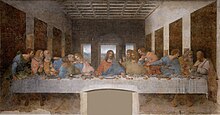



Milan is home to many cultural institutions, museums and art galleries, that account for about a tenth of the national total of visitors and receipts.[206] The Pinacoteca di Brera is one of Milan's most important art galleries. It contains one of the foremost collections of Italian painting, including masterpieces such as the Brera Madonna by Piero della Francesca. The Castello Sforzesco hosts numerous art collections and exhibitions, especially statues, ancient arms and furnitures, as well as the Pinacoteca del Castello Sforzesco, with an art collection including Michelangelo's last sculpture, the Rondanini Pietà, Andrea Mantegna's Trivulzio Madonna and Leonardo da Vinci's Codex Trivulzianus manuscript. The Castello complex also includes The Museum of Ancient Art, The Furniture Museum, The Museum of Musical Instruments and the Applied Arts Collection, The Egyptian and Prehistoric sections of the Archaeological Museum and the Achille Bertarelli Print Collection (Civica Raccolta delle Stampe Bertarelli).
Milan's figurative art flourished in the Middle Ages, and with the Visconti family being major patrons of the arts, the city became an important centre of Gothic art and architecture (Milan Cathedral being the city's most formidable work of Gothic architecture). Leonardo worked in Milan from 1482 until 1499. He was commissioned to paint the Virgin of the Rocks for the Confraternity of the Immaculate Conception and The Last Supper for the monastery of Santa Maria delle Grazie.[207]
The city was affected by the Baroque in the 17th and 18th centuries, and hosted numerous formidable artists, architects and painters of that period, such as Caravaggio and Francesco Hayez, which several important works are hosted in Brera Academy. The Museum of Risorgimento is specialised on the history of Italian unification Its collections include iconic paintings like Baldassare Verazzi's Episode from the Five Days and Francesco Hayez's 1840 Portrait of Emperor Ferdinand I of Austria. The Triennale is a design museum and events venue located in Palazzo dell'Arte, in Sempione Park. It hosts exhibitions and events highlighting contemporary Italian design, urban planning, architecture, music and media arts, emphasising the relationship between art and industry.
Milan in the 20th century was the epicentre of the futurist artistic movement. Filippo Marinetti, the founder of Italian Futurism wrote in his 1909 "Manifesto of Futurism" (in Italian, Manifesto Futuristico), that Milan was "grande...tradizionale e futurista" ("grand...traditional and futuristic", in English). Umberto Boccioni was also an important Futurism artist who worked in the city. Today, Milan remains a major international hub of modern and contemporary art, with numerous modern art galleries. The Modern Art Gallery, situated in the Royal Villa, hosts collections of Italian and European painting from the 18th to the early 20th centuries.[208][209][210] The Museo del Novecento, situated in the Palazzo dell'Arengario, is one of the most important art galleries in Italy about 20th-century art; of particular relevance are the sections dedicated to Futurism, Spatialism and Arte povera. In the early 1990s architect David Chipperfield was invited to convert the premises of the former Ansaldo Factory into a Museum. Museo delle Culture (MUDEC) opened in April 2015.[211] The Gallerie di Piazza Scala, a modern and contemporary museum located in Piazza della Scala in the Palazzo Brentani and the Palazzo Anguissola, hosts 195 artworks from the collections of Fondazione Cariplo with a strong representation of nineteenth-century Lombard painters and sculptors, including Antonio Canova and Umberto Boccioni. A new section was opened in the Palazzo della Banca Commerciale Italiana in 2012. Other private ventures dedicated to contemporary art include the exhibiting spaces of the Prada Foundation and HangarBicocca. The Nicola Trussardi Foundation is renewed for organising temporary exhibition in venues around the city. Milan is also home to many public art projects, with a variety of works that range from sculptures to murals to pieces by internationally renowned artists, including Arman, Kengiro Azuma, Francesco Barzaghi, Alberto Burri, Pietro Cascella, Maurizio Cattelan, Leonardo da Vinci, Giorgio de Chirico, Kris Ruhs, Emilio Isgrò, Fausto Melotti, Joan Miró, Carlo Mo, Claes Oldenburg, Igor Mitoraj, Gianfranco Pardi, Michelangelo Pistoletto, Arnaldo Pomodoro, Carlo Ramous, Aldo Rossi, Aligi Sassu, Giuseppe Spagnulo and Domenico Trentacoste.
Music
[edit]
Milan is a major national and international centre of the performing arts, most notably opera. The city hosts La Scala operahouse, considered one of the world's most prestigious,[213] having throughout history witnessed the premieres of numerous operas, such as Nabucco by Giuseppe Verdi in 1842, La Gioconda by Amilcare Ponchielli, Madama Butterfly by Giacomo Puccini in 1904, Turandot by Puccini in 1926, and more recently Teneke, by Fabio Vacchi in 2007. Other major theatres in Milan include the Teatro degli Arcimboldi, Teatro Dal Verme, Teatro Lirico and formerly the Teatro Regio Ducale. The city is also the seat of a renowned symphony orchestra and musical conservatory, and has been, throughout history, a major centre for musical composition: numerous famous composers and musicians such as Gioseppe Caimo, Simon Boyleau, Hoste da Reggio, Verdi, Giulio Gatti-Casazza, Paolo Cherici and Alice Edun lived and worked in Milan. The city is also the birthplace of many modern ensembles and bands, including I Camaleonti, Camerata Mediolanense, Gli Spioni, Dynamis Ensemble, Elio e le Storie Tese, Krisma, Premiata Forneria Marconi, Quartetto Cetra, Stormy Six, Le Vibrazioni and Lacuna Coil.
Fashion and design
[edit]
Milan is widely regarded as a global capital in industrial design, fashion and architecture.[214] In the 1950s and 60s, as the main industrial centre of Italy and one of Europe's most dynamic cities, Milan became a world capital of design and architecture. There was such a revolutionary change that Milan's fashion exports accounted for US$726 million in 1952, and by 1955 that number grew to US$72.5 billion.[215] Modern skyscrapers, such as the Pirelli Tower and the Torre Velasca were built, and artists such as Bruno Munari, Lucio Fontana, Enrico Castellani and Piero Manzoni gathered in the city.[216] Today, Milan is still particularly well known for its high-quality furniture and interior design industry. The city is home to FieraMilano, Europe's largest permanent trade exhibition, and Salone Internazionale del Mobile, one of the most prestigious international furniture and design fairs.[217]
Milan is also regarded as one of the fashion capitals of the world, along with New York City, Paris and London.[218] Milan is synonymous with the Italian prêt-à-porter industry,[219] as many of the most famous Italian fashion brands, such as Valentino, Versace, Prada, Armani and Dolce & Gabbana, are headquartered in the city. Numerous international fashion labels also operate shops in Milan. Furthermore, the city hosts the Milan Fashion Week twice a year, one of the most important events in the international fashion system.[220] Milan's main upscale fashion district, quadrilatero della moda, is home to the city's most prestigious shopping streets (Via Monte Napoleone, Via della Spiga, Via Sant'Andrea, Via Manzoni and Corso Venezia), in addition to Galleria Vittorio Emanuele II, one of the world's oldest shopping malls.[221] The term sciura encapsulates the look and culture of fashionable, elderly Milanese women.
Languages and literature
[edit]
In the late 18th century and throughout the 19th, Milan was an important centre for intellectual discussion and literary creativity. The Enlightenment found here a fertile ground. Cesare, Marquis of Beccaria, with his famous Dei delitti e delle pene, and Count Pietro Verri, with the periodical Il Caffè were able to exert a considerable influence over the new middle-class culture.
In the first years of the 19th century, the ideals of the Romantic movement made their impact on the cultural life of the city and its major writers debated the primacy of Classical versus Romantic poetry. Additionally, Giuseppe Parini and Ugo Foscolo published their most important works, and were admired by younger poets as masters of ethics, as well as of literary craftsmanship.
In the third decade of the 19th century, Alessandro Manzoni wrote his novel I Promessi Sposi, considered the manifesto of Italian Romanticism, which found in Milan its centre; in the same period Carlo Porta, reputed the most renowned local vernacular poet, wrote his poems in Lombard Language. The periodical Il Conciliatore published articles by Silvio Pellico, Giovanni Berchet, Ludovico di Breme, who were both Romantic in poetry and patriotic in politics.
After the Unification of Italy in 1861, Milan retained a sort of central position in cultural debates. New ideas and movements from other countries of Europe were accepted and discussed: thus Realism and Naturalism gave birth to prewar Italian movement of Verismo in Southern Italy, its greatest Verista novelist Giovanni Verga formed in Sicily who wrote his most important books in Milan.
In addition to Italian, approximately 2 million people in Northern Italy can speak the Milanese dialect or other Western Lombard variation.[224]
Media
[edit]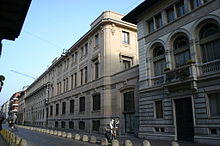
Milan is an important national and international media centre. Corriere della Sera, founded in 1876, is one of the oldest Italian newspapers, and it is published by Rizzoli, as well as La Gazzetta dello Sport, a daily dedicated to coverage of various sports and currently considered the most widely read daily newspaper in Italy. Other local dailies are the general broadsheets Il Giorno, Il Giornale, the Catholic newspaper Avvenire, and Il Sole 24 Ore, a daily business newspaper owned by Confindustria (the Italian employers' federation). Free daily newspapers include Leggo and Metro. Milan is also home to many architecture, art and fashion periodicals, including Abitare, Casabella, Domus, Flash Art, Gioia, Grazia and Vogue Italia. Panorama and Oggi, two of Italy's most important weekly news magazines, are also published in Milan.
Several commercial broadcast television networks have their national headquarters in the Milan conurbation, including Mediaset Group (owner of Canale 5, Italia 1, Iris and Rete 4), Telelombardia and MTV Italy. National radio stations based in Milan include Radio Deejay, Radio 105 Network, R101 (Italy), Radio Popolare, RTL 102.5, Radio Capital and Virgin Radio Italia.
Cuisine
[edit]
Like most cities in Italy, Milan has developed its own local culinary tradition, which, as it is typical for North Italian cuisines, uses more frequently rice than pasta, butter than vegetable oil and features almost no tomato or fish. Milanese traditional dishes includes cotoletta alla milanese, a breaded veal (pork and turkey can be used) cutlet pan-fried in butter (similar to Viennese Wiener Schnitzel). Other typical dishes are cassoeula (stewed pork rib chops and sausage with Savoy cabbage), ossobuco (braised veal shank served with a condiment called gremolata), risotto alla milanese (with saffron and beef marrow), busecca (stewed tripe with beans), mondeghili (meatballs made with leftover meat fried in butter) and brasato (stewed beef or pork with wine and potatoes).
Season-related pastries include chiacchiere (flat fritters dusted with sugar) and tortelli (fried spherical cookies) for Carnival, colomba (glazed cake shaped as a dove) for Easter, pane dei morti ("bread of the (Day of the) Dead", cookies flavoured with cinnamon) for All Souls' Day and panettone for Christmas. The salame Milano, a salami with a very fine grain, is widespread throughout Italy. Renowned Milanese cheeses are gorgonzola (from the namesake village nearby), mascarpone, used in pastry-making, taleggio and quartirolo.
The comune of San Colombano al Lambro, located about 40 kilometres (25 mi) south-east of Milan, is home to the Denominazione di origine controllata (DOC) wine which includes 100 hectares (250 acres) producing a single red wine. The finished wine must attain a minimum alcohol level of 11% to be labelled with the San Colombano DOC designation.[226]
Milan is well known for its world-class restaurants and cafés, characterised by innovative cuisine and design.[227] As of 2014[update], Milan has 157 Michelin-selected places, including three 2-Michelin-starred restaurants;[228] these include Cracco, Sadler and il Luogo di Aimo e Nadia.[229] Many historical restaurants and bars are found in the historic centre, the Brera and Navigli districts. Milan is home to the oldest restaurant in Italy and the second in Europe, the Antica trattoria Bagutto, which has existed since at least 1284.[225] One of the city's oldest surviving cafés, Caffè Cova, was established in 1817.[230] In total, Milan has 15 cafés, bars and restaurants registered among the Historical Places of Italy, continuously operating for at least 70 years.[231]
Sport
[edit]


Milan hosted matches at the FIFA World Cup in 1934 and 1990 and the UEFA European Championship in 1980, and more recently held the 2003 World Rowing Championships, the 2009 World Boxing Championships, and some games of the Men's Volleyball World Championship in 2010 and the final games of the Women's Volleyball World Championship in 2014. In 2018, Milan hosted the World Figure Skating Championships. Milan will host the 2026 Winter Olympics as well as the 2026 Winter Paralympics jointly with Cortina d'Ampezzo.
Milan, along with Manchester, is one of only two cities in Europe that is home to two European Cup/Champions League winning teams: Serie A football clubs AC Milan and Inter. They are two of the most successful clubs in the world of football in terms of international trophies. Both teams have also won the FIFA Club World Cup (formerly the Intercontinental Cup). With a combined ten Champions League titles, Milan is only second to Madrid as the city with the most European Cups. Both teams play at the UEFA 5-star-rated Giuseppe Meazza Stadium, more commonly known as the San Siro, that is one of the biggest stadiums in Europe, with a seating capacity of over 80,000.[232] The Meazza Stadium has hosted four European Cup/Champions League finals, most recently in 2016, when Real Madrid defeated Atlético Madrid 5–3 in a penalty shoot-out. A third team, Brera Calcio, plays in Prima Categoria, the seventh tier of Italian football.[233] Another team, Milano City FC (a successor of Bustese Calcio),[234] plays in Serie D, the fourth level.
Milan is one of the host cities of the EuroBasket 2022. There are currently four professional Lega Basket clubs in Milan: Olimpia Milano, Pallacanestro Milano 1958, Società Canottieri Milano and A.S.S.I. Milano. Olimpia is the most decorated basketball club in Italy, having won 27 Italian League championships, six Italian National Cups, one Italian Super Cup, three European Champions Cups, one FIBA Intercontinental Cup, three FIBA Saporta Cups, two FIBA Korać Cups and many junior titles. The team play at the Mediolanum Forum, with a capacity of 12,700, where it has been hosted the final of the 2013–14 Euroleague. In some cases the team also plays at the PalaDesio, with a capacity of 6,700.
Milan is also home to Italy's oldest American football team: Rhinos Milano, who have won five Italian Super Bowls. The team plays at the Velodromo Vigorelli, with a capacity of 8,000. Another American football team that use the same venue is the Seamen Milano, who joined the professional European League of Football in 2023. Milan has also two cricket teams: Milano Fiori, currently competing in the second division, and Kingsgrove Milan, who won the Serie A championship in 2014. Amatori Rugby Milano, the most decorated rugby team in Italy, was founded in Milan in 1927. The Monza Circuit, located near Milan, hosts the Formula One Italian Grand Prix.[235] The circuit is located inside the Royal Villa of Monza park. It is one of the world's oldest car racing circuits. The capacity for the Formula One races is currently over 113,000. It has hosted an Formula One race nearly every year since the first year of competition, with the exception of 1980.
In road cycling, Milan hosts the start of the annual Milan–San Remo classic one-day race and the annual Milano–Torino one day race. Milan is also the traditional finish for the final stage of the Giro d'Italia, which, along with the Tour de France and the Vuelta a España, is one of cycling's three Grand Tours.
Education
[edit]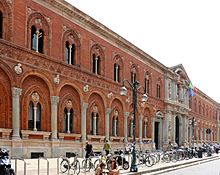
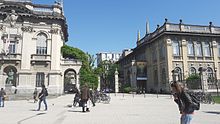
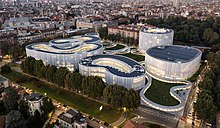

Milan is a major global centre of higher education teaching and research and has the second-largest concentration of higher education institutes in Italy after Rome. Milan's higher education system includes 7 universities, 48 faculties and 142 departments, with 185,000 university students enrolled in 2011 (approximately 11 percent of the national total)[23] and the largest number of university graduates and postgraduate students (34,000 and more than 5,000, respectively) in Italy.[238]
Universities
[edit]The University of Milan (also known as the "State University") founded in 1924,[239] is the largest public teaching and research university in the city.[240] The University of Milan is the sixth-largest university in Italy, with approximately 60,000 enrolled students and a teaching staff of 2,500.[241] Most relevant academics are in the fields of medicine, law and politics and sustainability. Notable alumni such as former Italian Prime Minister Silvio Berlusconi and Nobel laureates earned their degree at University of Milan.
University of Milano-Bicocca, established in 1998 is the city's newest institution of higher education in science and technology. Built over a once industrial area, today enrolls more than 30,000 students, of which more than 60% are female.[242] As its older parent institute, it is one of the most sought-after location for medical students.[243] It ranks as the 82nd-best young college on over 300 institutions in the 2020 Times Higher Education World University Rankings.[244]
The Polytechnic University of Milan is the city's oldest university, founded in 1863. With over 40,000 students, it is the largest technical university in Italy.[245] According to the QS World University Rankings for the subject area 'Engineering & Technology', it ranked in 2022 as the 13th best in the world.[246] It ranked 6th worldwide for Design, 9th for Civil and Structural Engineering, 9th for Mechanical, Aerospace Engineering and 7th for Architecture.[246] It is the best university in Italy.[236]
Catholic University of the Sacred Heart is the largest private teaching university in Europe[247] and the largest Catholic University in the world with 42,000 enrolled students.[248][249] Agostino Gemelli University Polyclinic serves as the teaching hospital for the medical school of the Università Cattolica del Sacro Cuore and owes its name to the university founder, the Franciscan friar, physician and psychologist Agostino Gemelli.[250]
Bocconi University is a private management and finance university established in 1902, ranking as the best university in Italy in its fields, and as one of the best in the world. In 2020, QS World University Rankings (viewed as one of the three most-widely read university rankings in the world) ranked the university seventh worldwide and third in Europe in business and management studies,[251] as well as first in economics and econometrics outside the US and the UK.[252] Financial Times ranked it the sixth-best business school in Europe in 2018.[253] Bocconi University also ranks as the fifth-best one-year MBA course in the world, according to the Forbes 2017 ranking.[254]
Vita-Salute San Raffaele University is a private teaching medical university linked to the San Raffaele Hospital.[255]
University Institute of Languages and Communication (also known as "University IULM") is a private teaching university established in 1968, later renamed from its original name "University Institute of Languages of Milan", becoming first Italian university offering courses on public relations; later it became a point of reference also for business communication; media and advertising; translation and interpreting; communication in culture and arts markets, tourism and fashion.[256]
Art academies
[edit]
Milan is also well known for its fine arts and music schools. The Milan Academy of Fine Arts (Brera Academy) is a public academic institution founded in 1776 by Empress Maria Theresa of Austria; the New Academy of Fine Arts is the largest private art and design university in Italy;[257] the European Institute of Design is a private university specialised in fashion, industrial and interior design, audio/visual design including photography, advertising and marketing and business communication; the Marangoni Institute, is a fashion institute with campuses in Milan, London and Paris; the Domus Academy is a private postgraduate institution of design, fashion, architecture, interior design and management; the Pontifical Ambrosian Institute of Sacred Music, a college of music founded in 1931 by the blessed cardinal A.I. Schuster, archbishop of Milan, and raised according to the rules by the Holy See in 1940, is—similarly to the Pontifical Institute of Sacred Music in Rome, which is consociated with—an Institute "ad instar facultatis" and is authorised to confer university qualifications with canonical validity[258] and the Milan Conservatory, a college of music established in 1807, currently Italy's largest with more than 1,700 students and 240 music teachers.[259]
Transport
[edit]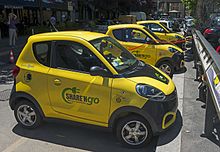
Milan is one of the key transport nodes of Italy and southern Europe. Its central railway station is Italy's second, after Rome Termini railway station, and Europe's eighth busiest.[260][261] The Malpensa, Linate and Orio al Serio airports serve the Greater Milan, the largest metropolitan area in Italy.
Azienda Trasporti Milanesi (ATM) is the Milanese municipal transport company; it operates 5 metro lines, 18 tram lines, 131 bus lines, 4 trolleybus lines and 1 people mover line, carrying about 776 million passengers in 2018.[262] Overall the network covers nearly 1,500 km (932 mi) reaching 46 municipalities.[263] Besides public transport, ATM manages the interchange parking lots and other transport services including bike sharing and carsharing systems.[264]
Rail
[edit]Underground
[edit]
The Milan Metro is the rapid transit system serving the city and surrounding municipalities. The network consists of 5 lines (M1, M2, M3, M4 and M5), with a total network length of 104 kilometres (65 mi), and a total of 121 stations, mostly underground.[266] It has a daily ridership of 1.15 million,[267] the largest in Italy as well as one of the largest in Europe.
The architectural project of the Milan Metro, created by Franco Albini and Franca Helg, and the signs, designed by Bob Noorda, received the Compasso d'Oro award in 1964.[268] Within the European Union it is the seventh-largest network in terms of kilometres.[269]
Suburban
[edit]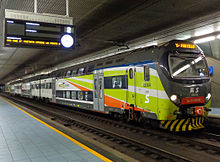
As of May 2023[update], the Milan suburban railway service, operated by Trenord, comprises 11 S lines connecting the metropolitan area with the city centre, with possible transfers to all the metro lines. Most S lines run through the Milan Passerby Railway, commonly referred to as "il Passante" and served by double-decker trains every 4/8 minutes in the central underground section.[270]
National and international trains
[edit]
Milan Central station, with 110 million passengers per year, is the largest and eighth-busiest railway station in Europe and the second busiest in Italy after Roma Termini.[260] Milano Centrale railway station is the largest railway station in Europe by volume.[271] Milano Cadorna and Milano Porta Garibaldi stations are, respectively, the seventh- and the eleventh-busiest stations in Italy.[260] Since the end of 2009, two high-speed train lines link Milan to Rome, Naples and Turin, considerably shortening travel times with other major cities in Italy. Further high-speed lines are under construction towards Genoa and Verona. Milan is served by direct international trains to Nice, Marseille, Lyon, Paris, Lugano, Geneva, Bern, Basel, Zurich and Frankfurt, and by overnight sleeper services to Munich and Vienna (ÖBB).[272] Overnight services to Paris were suspended in 2020 following the COVID lockdown and subsequently discontinued.[273][274]
Milan is also the core of Lombardy's regional train network. Regional trains were operated on two different systems by LeNord (departing from Milano Cadorna) and Trenitalia (departing from Milan Centrale and Milano Porta Garibaldi). Since 2011, a new company, Trenord, has operated both Trenitalia and LeNord regional trains in Lombardy, carrying over 750,000 passengers on more than 50 routes every day.[275][276]
Buses and trams
[edit]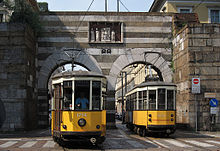
The city tram network consists of approximately 160 kilometres (99 mi) of track and 18 lines, and is Europe's most advanced light rail system.[278] Bus lines cover over 1,070 km (665 mi). Milan has also taxi services operated by private companies and licensed by the City Council of Milan. The city is also a key node for the national road network, being served by all the major highways of Northern Italy. Numerous long-distance bus lines link Milan with many other cities and towns in Lombardy and throughout Italy.[279]
Airports
[edit]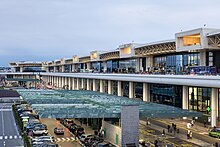

In the surroundings of Milan there are three airports dedicated to normal civilian traffic (Milan Malpensa Airport and Milan Linate Airport, managed by SEA, and Milan Bergamo Airport by SACBO).
Overall, the Milan airport system handles traffic of over 51.4 million passengers and around 700,000 tons of goods every year and is the first in Italy in terms of passenger volume and cargo volume (the second Italian airport system is Rome with 44.4 million passengers in 2023).[280] The Milan Malpensa airport, with over 700 thousand tons, confirms the national leadership, processing 70% of the country's air cargo.[281]
- The intercontinental hub of Milan Malpensa Airport (MXP) is Italy's second-busiest airport, after Rome Fiumicino Airport, with 24.1 million passengers served in 2023 and Italy's busiest for freight and cargo, handling about 700,000 tons of international freight in 2022. Malpensa Airport is the largest international airport in northern Italy, serving Lombardy, Piedmont and Liguria, as well as the Swiss Canton of Ticino. The airport is located 49 kilometres (30 mi) north-west of Milan,[282] in the province of Varese next to the Ticino river dividing Lombardy and Piedmont. Malpensa airport is 9th in the world and 6th in Europe for the number of countries served with direct scheduled flights[283] It is connected to Milan by the Malpensa Express railway service and by various bus lines.[284] The airport is located inside the Parco naturale lombardo della Valle del Ticino, a nature reserve included by UNESCO in the World Network of Biosphere Reserves.[285][286]
- Milan Linate Airport (LIN) is Milan's city airport, less than 8 kilometres (5 mi) from central Milan, and is mainly used for domestic and short-haul international flights. It served 8.6 million passengers in 2023 ranking as the 8th airport in Italy for passenger traffic.[287] Linate Airport is hub of ITA Airways together with Rome Fiumicino Airport and is connected the centre of Milan via the M4 blue metro line.
- Milan Bergamo Airport (BGY) is mainly used for low-cost, charter and cargo flights.[288] The airport is located in Orio al Serio, 3.7 km (2.3 mi) south-east of Bergamo and 45 km (28 mi) north-east of Milan. It is one of Ryanair's three main operating bases, along with Dublin Airport and London Stansted Airport.[289] It served 14.7 million passengers in 2023.[290] A bus service operated by ATB connects to the airport, about 10 minutes from the Bergamo railway station.[291]
Lastly, Bresso Airfield is a general aviation airport, operated by Aero Club Milano.[292] Since 1960 the airport mostly serves as a general aviation airfield for flying club activity, touristic flights and air taxi.[293] It also hosts a base of the state helicopter emergency service Elisoccorso.[294]
Cycling
[edit]
The bicycle is becoming an increasingly important mode of transportation in Milan. Since 2008, the implementation of a city-wide network of bike paths has been initiated, to fight congestion and air pollution. During the COVID pandemic in 2019, 35 km of bike lanes were realized on short notice, to relieve pressure on the subway occupation.[295]
The bike sharing system BikeMi has been deployed in almost all the city and enjoys increasing popularity. Stationless commercial bike and scooter sharing systems are widely available.
International relations
[edit]Twin towns – sister cities
[edit] São Paulo, Brazil, since 1961
São Paulo, Brazil, since 1961 Chicago, United States, since 1962
Chicago, United States, since 1962 Lyon, France, since 1967
Lyon, France, since 1967 Saint Petersburg, Russia, since 1967
Saint Petersburg, Russia, since 1967 Frankfurt, Germany, since 1969
Frankfurt, Germany, since 1969 Birmingham, United Kingdom, since 1974
Birmingham, United Kingdom, since 1974 Dakar, Senegal, since 1974
Dakar, Senegal, since 1974 Shanghai, China, since 1979
Shanghai, China, since 1979 Osaka, Japan, since 1981
Osaka, Japan, since 1981 Tel Aviv, Israel, since 1997
Tel Aviv, Israel, since 1997 Bethlehem, Palestine, since 2000
Bethlehem, Palestine, since 2000 Toronto, Canada, since 2003
Toronto, Canada, since 2003 Kraków, Poland, since 2003
Kraków, Poland, since 2003 Melbourne, Australia, since 2004
Melbourne, Australia, since 2004 Daegu, South Korea, since 2015
Daegu, South Korea, since 2015
The partnership with Saint Petersburg was suspended in 2012 (a decision taken by the city of Milan), because of the prohibition of the Russian government on "homosexual propaganda".[297] However, it was later restored and as of 2022, St. Petersburg is still listed on Milan's official list of twin towns.[296]
People
[edit]Honorary citizens
[edit]People awarded the honorary citizenship of Milan are:
| Date | Name | Notes |
|---|---|---|
| 24 February 1972 | Charlie Chaplin (1889–1977) | English comic actor |
| March 1980 | Andrei Sakharov (1921–1989) | Russian nuclear physicist, dissident and activist |
| December 1988 | Alexander Dubček (1921–1992) | Czechoslovak and Slovak politician and dissident |
| 16 February 1990 | Paola Borboni (1900–1995) | Italian actress |
| 21 October 2004 | Rudolph Giuliani (1944–present) | American politician, former mayor of New York City, and attorney of Donald Trump |
| 3 September 2005 | Rania Al-Abdullah (1970–present) | Queen consort of Jordan |
| 10 December 2008 | Al Gore (1948–present) | American politician and former Vice President of the United States |
| 18 January 2012 | Roberto Saviano (1979–present) | Italian journalist and writer |
| 4 April 2016 | Nino Di Matteo (1961–present) | Italian magistrate |
| 20 October 2016 | Dalai Lama (1935–present) | Tibetan Buddhist spiritual leader[298][299] |
| 10 December 2020 | Patrick Zaki (1991–present) | Egyptian student |
See also
[edit]- List of cities in the European Union by population within city limits
- Outline of Italy
- Outline of Milan
- Biscione
- History of architecture and art in Milan
References
[edit]- ^ "Resident Population on 1st January". www.comune.milano.it.
- ^ "Database". ec.europa.eu. Eurostat. Archived from the original on 16 September 2015. Retrieved 8 January 2020. click General and regional statistics / Regional statistics by typology / Metropolitan regions / Demography statistics by metropolitan regions / Population on 1 January by broad age group, sex and metropolitan regions (met_pjanaggr3)
- ^ In reference to the Meneghino mask.
- ^ "Gross domestic product (GDP) at current market prices by metropolitan regions". ec.europa.eu.
- ^ "Milan". Collins English Dictionary. HarperCollins. Archived from the original on 1 March 2019. Retrieved 28 February 2019.
- ^ "Milan". Merriam-Webster.com Dictionary. Merriam-Webster. Retrieved 28 February 2019.
- ^ "Where are the largest metropolitan regions in the EU? - Eurostat". ec.europa.eu. Retrieved 14 September 2024.
- ^ "Statistiche demografiche ISTAT". demo.istat.it. Archived from the original on 24 July 2019. Retrieved 23 November 2019.
- ^ "Milano". City Population. Retrieved 29 December 2023.
- ^ a b c Demographia: World Urban Areas Archived 3 May 2018 at the Wayback Machine. Retrieved 6 September 2015.
- ^ "Le aree metropolitane in Italia occupano il 9 per cento del territorio – Università degli Studi di Milano-Bicocca". www.old.unimib.it (in Italian). 6 December 2013.[permanent dead link]
- ^ a b *"OECD Territorial Reviews: Milan, Italy" (PDF). OECD. Retrieved 13 October 2017.[permanent dead link]
- Campagna, Michele; et al. (2012). Planning Support Tools: Policy Analysis, Implementation and Evaluation. Proceedings of the Seventh International Conference on Informatics and Urban and Regional Planning INPUT2012. Milan: FrancoAngeli. pp. 1853–1856. ISBN 978-88-568-7597-3.
- "Osservatorio sulla città metropolitana di Milano. Rapporto 2016" (PDF). Polytechnic University of Milan. Archived from the original (PDF) on 26 September 2017. Retrieved 13 October 2017.
- Salet, Willem; Thornley, Andy; Kreukels, Anton (2003). Metropolitan governance and spatial planning: comparative case studies of European city-regions. New York: Spon Press. p. 265. ISBN 978-0-415-27449-4.
- ^ a b "Milan, Italy's Industrial and Financial Capital". 18 May 2018. Retrieved 27 May 2022.
- ^ a b Astolfi, Marco; Romano, Delia (2007). Geoatlas (in Italian). Vol. 2. Bergamo: Atlas. pp. 56–57. ISBN 978-88-268-1362-2.
- ^ "GaWC – The World According to GaWC 2018". www.lboro.ac.uk. Archived from the original on 3 May 2017. Retrieved 16 December 2019.
- ^ "Milano cuore dell'industria chimica". Assolombarda.it. Archived from the original on 26 September 2022. Retrieved 18 July 2022.
- ^ "Gross domestic product (GDP) at current market prices by metropolitan regions". ec.europa.eu. Retrieved 25 April 2024.
- ^ "Regional gross domestic product by NUTS 2 regions – million EUR". ec.europa.eu. Retrieved 25 April 2024.
- ^ a b "Milano è la seconda città più amata dai turisti in Italia dopo la capitale" (in Italian). 4 July 2023. Retrieved 1 December 2023.
- ^ a b "Global Destination Cities Index 2019 di Mastercard: aumentano i turisti che scelgono l'Italia" (in Italian). Archived from the original on 6 November 2019. Retrieved 26 March 2020.
- ^ "Musei di Milano". museidimilano.it (in Italian). 16 February 2018. Archived from the original on 7 May 2023. Retrieved 7 May 2023.
- ^ "The Last Supper – Leonardo Da Vinci – Useful Information". www.milan-museum.com. Archived from the original on 28 March 2023. Retrieved 7 May 2023.
- ^ a b "University and research in Milan". Province of Milan. Archived from the original on 13 May 2013. Retrieved 4 November 2012.
- ^ "Migliori università al mondo, due sono a Milano: Politecnico e Bocconi". Il Giorno (in Italian). 22 March 2023. Archived from the original on 7 May 2023. Retrieved 7 May 2023.
- ^ a b c d e "Cronologia di Milano dalla fondazione fino al 150 d.C." (in Italian). Retrieved 11 July 2018.
- ^ a b c Tellier, Luc-Normand (2009). Urban World History. Québec: Press de l'Université du Québec. p. 274. ISBN 978-2-7605-1588-8.
- ^ "Quando Milano era capitale dell'Impero". Corriere della Sera. 24 November 2018. Archived from the original on 9 June 2023. Retrieved 14 September 2023.
- ^ a b Scott, Tom (2012). The City-State in Europe, 1000–1600: Hinterland, Territory, Region. OUP Oxford. p. 17. ISBN 978-0199274604.
- ^ kuneo_Cav (20 May 2019). "Storia del ducato di Milano: dai Visconti ai Sforza". Cavalleria San Maurizio (in Italian). Archived from the original on 27 October 2021. Retrieved 27 October 2021.
- ^ "Milan – story of a business capital of Europe". Italian Business Tips. 23 November 2018. Archived from the original on 27 October 2021. Retrieved 27 October 2021.
- ^ "Milan | History, Population, Climate, & Facts". Encyclopedia Britannica. Archived from the original on 27 October 2021. Retrieved 27 October 2021.
- ^ Shaw, Catherine (17 July 2016). "Milan, the 'world's design capital', takes steps to attract visitors year-round". South China Morning Post. Archived from the original on 16 October 2017. Retrieved 15 October 2017.
- ^ Kaufman, Sara (18 July 2018). "10 Milan Fashion Brands You Need to Know". Culture Trip. Archived from the original on 10 April 2023. Retrieved 10 April 2023.
- ^ "Le vie del Quadrilatero della Moda di Milano". Italia.it (in Italian). Archived from the original on 25 March 2023. Retrieved 10 April 2023.
- ^ "Fashion". The Global Language Monitor. Archived from the original on 3 June 2011. Retrieved 1 June 2011.
- ^ "Milan, Italy | frog". Frog.co previously frogdesign.com. Archived from the original on 1 May 2011. Retrieved 1 June 2011.
- ^ "Milan Furniture Fair". Monocle.com. 30 April 2009. Archived from the original on 13 July 2012. Retrieved 10 July 2012.
- ^ "Guida Michelin 2016: ristoranti stellati in Lombardia". Archived from the original on 2 May 2016. Retrieved 7 May 2016.
- ^ "Lausanne To Host Vote For Winning 2026 Winter Olympic Bid Instead of Milan After Italy Enters Race". GamesBids. 20 September 2018. Archived from the original on 24 April 2020. Retrieved 1 November 2021.
- ^ "IOC To Move Up 2026 Olympic Bid Vote Three Months, Now June 2019". GamesBids. 9 October 2018. Archived from the original on 24 April 2020. Retrieved 1 November 2021.
- ^ "Winter Olympics: Italy's Milan-Cortina bid chosen as host for the 2026 Games". BBC. 24 June 2019. Archived from the original on 10 September 2019. Retrieved 1 November 2021.
- ^ Delamarre, Xavier (2003). Dictionnaire de la langue gauloise (in French) (2nd ed.). Paris: Errance. pp. 221–222. ISBN 2-87772-237-6.
- ^ a b García Quintela, Marco (2005). "Celtic Elements in Northwestern Spain in Pre-Roman times"". Journal of Interdisciplinary Celtic Studies.
[...] a toponym, clearly in the second part of the composite Medio-lanum (=Milan), meaning 'plain' or flat area [...]
- ^ L.Cracco Ruggini, Milano da "metropoli" degli Insubri a capitale d'Impero: una vicenda di mille anni, in Catalogo della Mostra "Milano capitale dell'Impero romani (286-402 d.C.)", edited by Gemma Sena Chiesa, Milano, 1990, p.17.
- ^ Ambrogio, Renzo (2009). Nomi d'Italia : origine e significato dei nomi geografici e di tutti i comuni. Novara: Istituto geografico De Agostini. p. 385. ISBN 978-88-511-1412-1.
- ^ Wise, Hilary (1997). The vocabulary of modern French origins, structure and function. London: Routledge. p. 39. ISBN 0-203-42979-6.
- ^ Michell, John (2009). The sacred center: the ancient art of locating sanctuaries. Rochester, Vt.: Inner Traditions. p. 32. ISBN 978-1-59477-284-9.
- ^ medius + lanum; Alciato's "etymology" is intentionally far-fetched.
- ^ Bituricis vervex, Heduis dat sucula signum.
- ^ Laniger huic signum sus est, animálque biforme, Acribus hinc setis, lanitio inde levi.
- ^ "Alciato, Emblemata, Emblema II". Emblems.arts.gla.ac.uk. Archived from the original on 13 January 2012. Retrieved 13 March 2009.
- ^ Livius, Ab Urbe condita 5.34–35.3.
- ^ a b c d e f g Tosi, Stefano (2 May 2016). Da Milano alla Barona. Storia, luoghi e persone di questa terra (in Italian). Lulu.com. ISBN 978-1-326-64414-7. Retrieved 16 July 2018.
- ^ Polybius. "Histories". Retrieved 11 July 2024.
- ^ Delamarre, Xavier (2003). Dictionnaire de la langue gauloise (in French) (2nd ed.). Paris: Errance. pp. 221–222. ISBN 2-87772-237-6.
- ^ "Le colonie romane" (in Italian). Retrieved 6 June 2018.
- ^ "Mediolanum-Milano" (in Italian). Retrieved 8 July 2018.
- ^ "Video of Roman Milan". Archived from the original on 5 May 2018. Retrieved 24 November 2018.
- ^ Benario, Herbert W. (1981). "Amphitheatres of the Roman World". The Classical Journal. 76 (3): 255–258. JSTOR 3297328.
- ^ Compare:
Doyle, Chris (2018). "The move to Ravenna". Honorius: The Fight for the Roman West AD 395–423. Roman Imperial Biographies. Abingdon, Oxfordshire: Routledge. ISBN 978-1-317-27807-8. Archived from the original on 13 June 2020. Retrieved 20 January 2019.
A subject that has often been debated is Honorius' transfer of his court to Ravenna. Consensus holds that this occurred in 402 as a result of Alaric's siege of Milan, although no Honorian-era written primary source attests to this as the year or the reason [...].
- ^ See the Laudes Mediolanensis civitatis.
- ^ "Milan: a history of greatness, from its origins to the twentieth century". Portale per il Turismo del Comune di Milano. Archived from the original on 29 April 2017. Retrieved 15 May 2017.
- ^ Walford, Edward; Cox, John Charles; Apperson, George Latimer (1885). "Digit folklore, part II". The Antiquary. XI: 119–123.
- ^ Novobatzky, Peter; Shea, Ammon (2001). Depraved and Insulting English. Orlando: Harcourt. ISBN 9780156011495.
- ^ Lecco, Alberto; Foot, John (2020). "Milan Italy". Encyclopedia Britannica. Encyclopedia Britannica, Inc. Retrieved 4 February 2020.
- ^ "History of Italy". HistoryWorld. p. 2. Retrieved 4 February 2020.
- ^ a b Henry S. Lucas, The Renaissance and the Reformation p. 268.
- ^ "The History of Milan – Relazioni Internazionali – Università Cattolica del Sacro Cuore". internationalrelations.unicatt.it. Archived from the original on 8 November 2009. Retrieved 14 January 2010.
- ^ "Milan – History". Encyclopedia Britannica. Retrieved 17 December 2020.
- ^ John Lothrop Motley, The Rise of the Dutch Republic Vol. II (Harper Bros.: New York, 1855) p. 2.
- ^ Cipolla, Carlo M. Fighting the Plague in Seventeenth Century Italy. Madison: University of Wisconsin Press, 1981.
- ^ "Lombardo-Veneto, Regno" (in Italian). Treccani. Retrieved 29 October 2023.
- ^ Graham J. Morris. "Solferino". Archived from the original on 30 June 2009. Retrieved 9 June 2009.
- ^ "Orient Express, quando tra Londra e Costantinopoli c'erano le fermate a Stresa e Pallanza" (in Italian). 15 June 2012. Retrieved 29 October 2023.
- ^ "Le cannonate di Bava Beccaris, 120 anni fa" (in Italian). 8 May 2018. Retrieved 29 October 2023.
- ^ Morgan, Philip (2008). The fall of Mussolini: Italy, the Italians, and the Second World War (Reprint. ed.). Oxford: Oxford University Press. p. 67. ISBN 978-0-19-921934-6.
- ^ Cooke, Philip (1997). Italian resistance writing: an anthology. Manchester: Manchester University Press. p. 20. ISBN 0-7190-5172-X.
- ^ Ginsborg, Paul (2003). A history of contemporary Italy: society and politics, 1943 – 1988. New York: Palgrave Macmillan. p. 220. ISBN 1-4039-6153-0.
- ^ a b c Foot, John (2001). Milan since the miracle: city, culture, and identity. New York: Berg. p. 119. ISBN 1-85973-545-2.
- ^ "Italian Stock Exchange – Main indicators 1975–2012". Archived from the original on 6 November 2018. Retrieved 16 October 2012.
- ^ "L'uomo che inventò la Milano da bere". Lastampa.It. 4 January 2008. Archived from the original on 14 September 2009. Retrieved 25 March 2010.
- ^ Mieg, Harald A.; Overmann, Heike. Industrial heritage sites in transformation : clash of discourses. New York and London: Rutledge. p. 72. ISBN 978-1-315-79799-1.
- ^ "New Milan Exhibition System official website". Archived from the original on 1 December 2011. Retrieved 29 October 2012.
- ^ Ni, Pengfei (2012). The global urban competitiveness report 2011. Cheltenham: Edward Elgar. p. 127. ISBN 978-0-85793-421-5.
- ^ "Metropoli Milano 2016" (PDF). Statistical Service of the Metropolitan City of Milan. Archived from the original (PDF) on 2 August 2016. Retrieved 26 July 2016.
- ^ Raffaele Pugliese, Marco Lucchini (2009). Milano città d'acqua: nuovi paesaggi urbani per la tutela dei navigli. Florence: Alinea. p. 32. ISBN 978-88-6055-469-7.
- ^ King, Russell (1985). The industrial geography of Italy. London: Croom Helm. pp. 250–254. ISBN 0-7099-1501-2.
- ^ Italy Green Guide, Michelin, 2012-2013, entry for Navigli, Milan
- ^ "The ENVIBASE-Project – Climate of Milan". Archived from the original on 28 February 2019. Retrieved 14 August 2012.
- ^ [1] archive
- ^ "Weather Overview for Milan". Holyday-Weather.com. Archived from the original on 29 May 2018. Retrieved 14 August 2012.
- ^ "Recorded temperatures, Milan". Accuweather. Archived from the original on 26 June 2019. Retrieved 14 August 2012.
- ^ "Smog in Northern Italy". NASA. 29 December 2005. Archived from the original on 11 June 2020. Retrieved 14 August 2012.
- ^ "Italy's northern cities rated among the worst in Europe for air pollution". The Local Italy. 18 June 2021. Archived from the original on 26 May 2022. Retrieved 1 April 2022.
- ^ "Historical temperatures, Milan". Accuweather. Archived from the original on 30 August 2018. Retrieved 14 August 2012.
- ^ a b c d "Average weather in Milan". WeatherSpark. Archived from the original on 2 April 2016. Retrieved 14 August 2012.
- ^ "Average monthly precipitation over the year (rainfall, snow)". World weather and climate information. Archived from the original on 30 August 2018. Retrieved 14 August 2012.
- ^ "World Meteorological Organization Climate Normals for 1991-2020: Milano-Linate" (CSV). ncei.noaa.gov (Excel). NOAA. Retrieved 29 February 2024.
- ^ "WMO Climate Normals for 1981-2010: Milano-Linate-16080" (XLS). ncei.noaa.gov. NOAA. Retrieved 29 February 2024.
Parameter Code: 8 - Total number of hours of sunshine
- ^ "Valori climatici normali in Italia". Istituto Superiore per la Protezione e la Ricerca Ambientale. Archived from the original on 17 September 2023. Retrieved 17 September 2023.
- ^ "Milan/Malpensa (16066) - WMO Weather Station". NOAA. Retrieved 17 July 2019.
- ^ "Indices Data – Milano Malpensa STAID 1712". KNMI. Retrieved 2 March 2020.
- ^ "The Borough Councils of Milan". Municipality of Milan. Archived from the original on 18 April 2015. Retrieved 18 October 2012.
- ^ "The Municipal Statute of Milan". Municipality of Milan. Archived from the original on 16 March 2015. Retrieved 18 October 2012.
- ^ "Local self-government authority system under the Italian legislation". Italian Ministry of Internal Affairs. Archived from the original on 18 February 2017. Retrieved 18 October 2012.
- ^ "Spending Review Act". Italian Government. Archived from the original on 14 July 2012. Retrieved 18 October 2012.
- ^ "Metropolitan cities in Italy". Archived from the original on 31 May 2020. Retrieved 26 May 2020.
- ^ "Council on Tall Buildings and Urban Habitat". Archived from the original on 27 October 2012. Retrieved 18 October 2012.
- ^ a b See List of largest church buildings in the world.
- ^ Wilson, Sharon (2011). A perfect trip to Italy in the golden years. Bloomington, IN: iUniverse Inc. p. 93. ISBN 978-1-4502-8443-1.
- ^ "The Castle Reconstructed by the Sforza". Castello Sforzesco website. Archived from the original on 30 August 2003.
- ^ Murray, Peter (1986). "Milan: Filarete, Leonardo Bramante". The Architecture of the Italian Renaissance. Thames and Hudson. pp. 105–120.
- ^ Wittkower, Rudolf (1993). "Art and Architecture Italy, 1600–1750". Pelican History of Art. 1980. Penguin Books.
- ^ Wilson, Ellen Judy (2004). Reill, Peter Hanns (ed.). Encyclopedia of the enlightenment (Rev. ed.). New York, NY: Facts on File. p. 392. ISBN 0-8160-5335-9.
- ^ Mazzocca, Fernando (2007). La Galleria d'Arte Moderna e la Villa Reale di Milano. Cinisello Balsamo (Milano): Silvana. p. 21. ISBN 978-88-366-1003-7.
- ^ De Finetti, Giuseppe (2002). Milano : costruzione di una città. Milano: U. Hoepli. p. 324. ISBN 88-203-3092-X.
- ^ a b "Storia di Milano ::: Palazzi e case liberty". Storiadimilano.it. Archived from the original on 15 June 2012. Retrieved 10 July 2012.
- ^ "Verso Una Conclusione: Casa Berri Meregalli". 100milano.com. Archived from the original on 24 April 2012. Retrieved 10 July 2012.
- ^ "Castello Cova – info2015expo". Info2015expo.it. Archived from the original on 24 April 2012. Retrieved 10 July 2012.
- ^ Birmingham, Brenda (2011). DK Eyewitness Travel Guide: Milan & the Lakes. London: Dorling Kindersley Limited. ISBN 978-1-4053-6747-9. OCLC 828734755. Archived from the original on 29 May 2021. Retrieved 17 November 2020.
- ^ "Isozaki Tower – CityLife". City-life.it. Archived from the original on 14 October 2012. Retrieved 10 July 2012.
- ^ "Torre Hadid – CityLife – CityLife". City-life.it. Archived from the original on 14 October 2012. Retrieved 10 July 2012.
- ^ "Liebskind Tower – CityLife". City-life.it. Archived from the original on 15 October 2012. Retrieved 10 July 2012.
- ^ "La nostra storia" [Our History] (in Italian). City of Milan. Archived from the original on 20 January 2015. Retrieved 16 August 2018.
- ^ "Sempione Park". Archived from the original on 10 April 2014. Retrieved 13 June 2013.
- ^ "Indro Montanelli Gardens". Archived from the original on 8 May 2014. Retrieved 13 June 2013.
- ^ "Forlanini Park". Archived from the original on 10 April 2014. Retrieved 13 June 2013.
- ^ "La storia del Parco" (in Italian). 18 October 2019. Retrieved 29 October 2023.
- ^ "Parco Agricolo Sud Milano" (in Italian). Retrieved 29 October 2023.
- ^ "Parco delle Cave" (in Italian). Retrieved 29 October 2023.
- ^ "Historical population, 1861–2014". Istat. Archived from the original on 15 October 2017. Retrieved 14 October 2017.
- ^ "Popolazione residente nel Comune di Milano al 31/12/2023".
- ^ "Bilancio demografico mensile". demo.istat.it. Retrieved 22 October 2024.
- ^ Malfreda, Germano; Pizzorni, Geoffry John; Ricciardi, Ferruccio; Romano, Roberto (2006). Lavoro e società nella Milano del Novecento. Milano: Angeli. p. 331. ISBN 978-88-464-8031-6.
- ^ "Popolazione straniera residente nel Comune di Milano al 01/01/2021 per sesso e nazionalità". Archived from the original on 10 August 2022. Retrieved 25 March 2022.
- ^ a b c "Popolazione straniera residente nel Comune di Milano al 31/12/2023 per sesso e nazionalità".
- ^ "Popolazione anagrafica straniera residente nel Comune di Milano Anno Sesso Totale in serie storica dal 1999 al 2016". Municipality of Milan. Archived from the original on 7 November 2017. Retrieved 3 November 2017.
- ^ Foot, John. "Mapping Diversity in Milan. Using the administrative division of the Milanese territory in the functional areas some important aspects of the spatial distribution of demographic phenomena can be captured. As well as the aggregated data on the stocks, the individual information (also geographically referenced) by the population register are considered for this purpose. The stocks at the 1st on January of the years from 2005 to 2009 are available. The totals for individuals and family are consistent with the totals published by ISTAT (National Institute of Statistics) by means of appropriate scaling coefficients, since some differences can occur between the two sources. Historical Approaches to Urban Immigration" (PDF). Fondazione Eni Enrico Mattei. Archived (PDF) from the original on 20 August 2016. Retrieved 23 July 2016.
- ^ Istituto Nazionale di Urbanistica della Lombardia (1999). Lombardia, politiche e regole per il territorio. Florence: Alinea Editrice. p. 139. ISBN 88-8125-332-1.
- ^ "Statistiche Demografiche Cittadini stranieri Milano 2021" (in Italian). tuttitalia.it. Archived from the original on 28 July 2021. Retrieved 5 November 2021.
- ^ Antonella Ceccagno (1997). ll caso delle comunità cinesi: comunicazione interculturale ed istituzioni. Rome: Armando Editore. pp. 29–35. ISBN 88-7144-718-2.
- ^ "ミラノ日本人学校・Scuola Giapponese di Milano" (in Japanese). Retrieved 22 October 2024.
- ^ "Cinese, la lingua del futuro: ecco dove impararlo a Milano". MilanoToday (in Italian). Retrieved 22 October 2024.
- ^ Chisholm, Hugh, ed. (1911). . Encyclopædia Britannica. Vol. 9 (11th ed.). Cambridge University Press. p. 747.
- ^ Agatha Ramm, "Great Britain and the Planting of Italian Power in the Red Sea, 1868-1885", The English Historical Review, Vol. 59, No. 234 (May, 1944), p. 214–215.
- ^ Chisholm, Hugh, ed. (1911). . Encyclopædia Britannica. Vol. 9 (11th ed.). Cambridge University Press. p. 90–119.
- ^ Palmisano, Lucio. "La comunità eritrea ha portato Asmara a Milano". www.editorialedomani.it (in Italian). Retrieved 22 October 2024.
- ^ "Eritrea, Milano". Rivista Studio (in Italian). 12 July 2017. Retrieved 22 October 2024.
- ^ "Oltre lo zighinì". zero.eu. Retrieved 22 October 2024.
- ^ "Il mondo a Milano: dal corno d'Africa a porta Venezia" (in Italian). 24 November 2020. Retrieved 22 October 2024.
- ^ Scego, Igiaba (5 May 2015). "Un angolo di Eritrea a Milano". Internazionale (in Italian). Retrieved 22 October 2024.
- ^ "Chiesa Ortodossa d'Etiopia". Consiglio delle Chiese Cristiane di Milano (in Italian). Retrieved 22 October 2024.
- ^ Miranda, Hari De (16 January 2023). "L'Asmarina di Buenos Aires: il quartiere più esotico di Milano". Milano Città Stato (in Italian). Retrieved 22 October 2024.
- ^ Giuzzi, Cesare (4 December 2021). "Da San Siro il rap delle case popolari Neima Ezza, la generazione «perif» e la rabbia del quartiere-ghetto". Corriere della Sera (in Italian). Retrieved 22 October 2024.
- ^ "Milano, sulla frontiera tra le due città: a San Siro il muro invisibile di piazzale Segesta tra il disagio delle case popolari e il lusso". la Repubblica (in Italian). 22 December 2021. Retrieved 22 October 2024.
- ^ "Case Aler, viaggio nella casbah di San Siro tra rifiuti e case occupate". la Repubblica (in Italian). 12 February 2018. Retrieved 22 October 2024.
- ^ Schiavi, Giangiacomo (19 May 2021). "San Siro, il mondo che vive separato nella «casbah»". Corriere della Sera (in Italian). Retrieved 22 October 2024.
- ^ "Accoltellato al viso e alla schiena nella casbah di San Siro: grave un 30enne". la Repubblica (in Italian). 5 September 2023. Retrieved 22 October 2024.
- ^ Florio, Felice (1 March 2021). "Danni collaterali - Nel quartiere arabo di Milano, dove il Coronavirus colpisce i più deboli: «La speranza è nel sorriso degli abitanti»". Open (in Italian). Retrieved 22 October 2024.
- ^ ""Barrio San Siro": il quartiere dove la violenza è lo stigma sociale e non solo cronaca nera". la Repubblica (in Italian). 11 May 2022. Retrieved 22 October 2024.
- ^ "Quella casbah chiamata Milano". ilGiornale.it (in Italian). 25 October 2006. Retrieved 22 October 2024.
- ^ "Così a Milano è cresciuta una piccola Molenbeek, pronta a incendiarsi". www.ilfoglio.it (in Italian). Retrieved 22 October 2024.
- ^ "Istantanee-di-San-Siro.-Presente-e-futuro-del-quartiere" (PDF).
- ^ "Corvetto".
- ^ "A virtual immersion in Corvetto Neighbourhood".
- ^ "Cristiana Shahata, la donna che aiuta le donne arabe allo sportello postale: "A loro dico di cercare di integrarsi"". la Repubblica (in Italian). 6 March 2023. Retrieved 22 October 2024.
- ^ "Italy". Catholic-Hierarchy.org. David M. Cheney. Retrieved 21 January 2015.
- ^ "Being Christian in Western Europe" (PDF). Pew Research Center. 2018. Archived from the original (PDF) on 2 August 2019. Retrieved 3 February 2020.
- ^ "Christian Churches in Milan". Yesmilano.it. Milan Tourism Office. Archived from the original on 30 December 2019. Retrieved 30 December 2019.
- ^ "Jewish Community of Milan". Mosaico-cem.it. Archived from the original on 9 March 2018. Retrieved 13 March 2009.
- ^ Povoledo, Elisabetta (29 April 2018). "What May Life in Italy Be Like Under the Right? These Immigrants Already Know". The New York Times. Archived from the original on 30 December 2019. Retrieved 30 December 2019.
- ^ "Lankarama Buddhist Temple – Milan, Italy". Lankaramaya.com. Archived from the original on 8 May 2019. Retrieved 13 March 2009.
- ^ "Immigrants and religion in Italy: Orthodox overtake Muslims" (PDF). ISMU Foundation. Archived (PDF) from the original on 1 January 2020. Retrieved 1 January 2020.
- ^ Alan, Kreider (2001). The origins of Christendom in the West. Edinburgh & New York: T & T Clark. p. 56. ISBN 0-567-08776-X.
- ^ Bishop, William Chatterley (1924). The Mozarabic and Ambrosian Rites: Four Essays in Comparative Liturgiology. London: Longmans, Green and Company. p. 98.
- ^ "Milano laica e religiosa" (in Italian). L'Osservatore Romano. 3 June 2012. Retrieved 15 March 2013.[dead link]
- ^ "Catholic Encyclopedia: Ambrosian Chant". Newadvent.org. 1 March 1907. Archived from the original on 12 June 2010. Retrieved 13 March 2009.
- ^ Monnot, Christophe; Stolz, Joerg (14 May 2018). Congregations in Europe. Berlin: Springer. p. 63. ISBN 978-3-319-77261-5.
- ^ "Chiesa di Santa Maria della Vittoria". Yesmilano.it. Milan Tourism Office. Archived from the original on 29 December 2019. Retrieved 29 December 2019.
- ^ Valli, Aldo Maria (2009). Voi mi sarete testimoni: Dionigi Tettamanzi arcivescovo a Milano (1. ed.). Milan: Rizzoli. ISBN 978-88-17-03661-0.
- ^ Calvesi, Maurizio; Zuccari, Alessandro (2008). Da Caravaggio ai Caravaggeschi. Rome: CAM Editrice. p. 63. ISBN 978-88-904842-0-9.
- ^ Lerman, Antony; David M., Jacobs; Lena, Stanley-Clamps; Anne, Frankel; Alan, Montague (1989). Jewish Communities of the World (4th ed.). Palgrave Macmillan, a division of Macmillan Publishers Limited. p. 94. ISBN 978-1-349-10534-2.
- ^ Castelli Gattinara, Pietro (2016). The politics of migration in Italy : perspectives on local debates and party competition. New York: Rutledge. p. 68. ISBN 978-1-138-64256-0.
- ^ Modood, Tariq; Triandafyllidou, Anna; Zapata-Barrero, Ricard (2006). Multiculturalism, Muslims, and citizenship : a European approach. New York: Routledge. p. 68. ISBN 978-0-415-35514-8.
- ^ Martelli, Adelaide (2021). First Section: Data Regarding the Muslim Population in Italy (Report). International Institute for Counter-Terrorism (ICT). pp. 10–39.
- ^ Rajan, S. Irudaya (2019). India migration report 2018 : migrants in Europe (1st ed.). New York: Routledge. ISBN 978-1-138-49816-7.
- ^ Giordan, Giuseppe; Swatos, William H. (2013). Testing pluralism : globalizing belief, localizing gods. Leiden: Brill. p. 82. ISBN 978-90-04-25447-3.
- ^ Hundal, Sunny (4 August 2017). "Why the Indian government must help Italian Sikhs". Hindustan Times. Archived from the original on 30 December 2019. Retrieved 30 December 2019.
- ^ a b "Ranking of the world's largest exhibition halls in 2018, by gross hall capacity". Statista. Archived from the original on 3 February 2020. Retrieved 3 February 2020.
- ^ a b "Via Monte Napoleone scala la classifica mondiale delle strade del lusso: seconda solo alla Fifth Avenue di New York". 30 November 2023.
- ^ "Scopri dove vivono in Italia i ricchi (che pagano le tasse)" (in Italian). Il Sole 24 Ore. 18 July 2023. Retrieved 27 November 2023.
- ^ "Territorial economic accounts. Value of the main aggregates (1). Total value – Regional – RSY Lombardia". www.asr-lombardia.it. Archived from the original on 31 October 2018. Retrieved 27 November 2017.
- ^ "Prodotto interno lordo". Comune di Bologna. Archived from the original on 31 December 2019. Retrieved 31 December 2019.
- ^ "Gross domestic product (GDP) at current market prices by NUTS 3 regions". Eurostat. Archived from the original on 26 June 2019. Retrieved 7 December 2017.
- ^ "Gross domestic product (GDP) at current market prices by NUTS 2 regions". Archived from the original on 6 October 2014. Retrieved 15 November 2017.
- ^ "Fortune 500 – 2011 ranking by location". Archived from the original on 17 February 2019. Retrieved 21 October 2012.
- ^ Beswick, Emma (19 March 2019). "Europe is home to some of the most expensive cities in the world in 2019 — where are they?". Euronews. Archived from the original on 9 January 2020. Retrieved 30 December 2019.
- ^ a b "Milan: city profile". Municipality of Milan. Archived from the original on 5 March 2016. Retrieved 29 May 2021.
- ^ "MICROSOFT HOUSE – THE STUNNING HEADQUARTERS OF MICROSOFT ITALY Through the Keyhole". news.microsoft.com. Microsoft News Centre Europe. 7 March 2017. Archived from the original on 31 December 2019. Retrieved 31 December 2019.
- ^ "2018 Sustainability Report Consolidated disclosure of non-financial information pursuant to Legislative Decree 254/2016" (PDF). Fiera Milano. Archived (PDF) from the original on 3 February 2020. Retrieved 3 February 2020.
- ^ "Global Destination Cities Index by Mastercard, 2018 edition". Archived from the original on 28 September 2018. Retrieved 28 April 2019.
- ^ "places to go in milan". Archived from the original on 2 April 2015. Retrieved 27 February 2015.
- ^ "Heaven at Milan's Town House Galleria hotel". The Age. Melbourne. 7 January 2009. Retrieved 21 January 2009.
- ^ "STATE MUSEUMS AND ART GALLERIES. NUMBER OF VISITORS AND RECEIPTS BY TYPE OF ADMISSION AND TYPE OF INSTITUTE, 2011". Province of Milan. Archived from the original on 8 May 2014. Retrieved 14 June 2013.
- ^ Kemp, Martin (2004). Leonardo.
- ^ "Galleria d'Arte moderna di Milano". GAM Milano. Archived from the original on 25 November 2012. Retrieved 29 September 2012.
- ^ Le città d'arte: Milano, Guide brevi Skira, ed.2008, autori vari (Italian language).
- ^ Milan, Lonely Planet Encounter Guides, 1st Edition, January 2009 (English language).
- ^ "Museum of Cultures Completes in Milan". archdaily.com. 10 April 2015. Archived from the original on 19 September 2016. Retrieved 13 September 2016.
- ^ Griffin, Clive (2007). Opera (1st U.S. ed.). New York: Collins. p. 172. ISBN 978-0-06-124182-6.
- ^ Willey, David (12 November 2005). "Europe | La Scala faces uncertain future". BBC News. Archived from the original on 8 May 2014. Retrieved 3 January 2010.
- ^ Knox, Paul L. (2010). Cities and design. London: Routledge. pp. 228–235. ISBN 978-0-203-84855-5.
- ^ Merlo, Elisabetta; Polese, Francesca (October 2006). "Cambridge Journals Online – Business History Review – Abstract – Turning Fashion into Business: The Emergence of Milan as an International Fashion Hub". Business History Review. 80 (3): 415–447. doi:10.1017/S0007680500035856. ISSN 0007-6805. S2CID 156857344. Archived from the original on 14 July 2016. Retrieved 24 January 2015.
- ^ "Frieze Magazine | Archive | Milan and Turin". Frieze.com. Archived from the original on 12 November 2007. Retrieved 3 January 2010.
- ^ "Salone Internazionale del Mobile official website". Archived from the original on 10 April 2013. Retrieved 15 April 2013.
- ^ "New York Takes Top Global Fashion Capital Title from London, edging past Paris". Languagemonitor.com. 3 February 2015. Archived from the original on 21 May 2017. Retrieved 9 May 2017.
- ^ Bye, Elizabeth (2010). Fashion design (English ed.). Oxford: Berg. pp. 136–137. ISBN 978-1-84788-266-0.
- ^ "Milan Fashion Week – Home of the best". Mojeh Magazine. Archived from the original on 15 March 2013. Retrieved 15 April 2013.
- ^ Klaffke, Pamela (2003). Spree : a cultural history of shopping. Vancouver, B.C.: Arsenal Pulp Press. p. 46. ISBN 1-55152-143-1.
- ^ "Alessandro Manzoni | Italian author". Encyclopedia Britannica. 18 May 2023.
- ^ "I Promessi sposi or The Betrothed". Archived from the original on 18 July 2011.
- ^ Coluzzi, Paolo (2007). Minority language planning and micronationalism in Italy: an analysis of the situation of Friulian, Cimbrian and Western Lombard with reference to Spanish minority languages. Oxford: New York. p. 260. ISBN 978-3-03911-041-4.
- ^ a b "Antica trattoria Bagutto" (in Italian). Archived from the original on 30 April 2013. Retrieved 29 November 2020.
- ^ P. Saunders Wine Label Language pg 198 Firefly Books 2004 ISBN 1-55297-720-X
- ^ "Where Are the World's Best Shopping and Dining Destinations?". Four Seasons Magazine. Archived from the original on 15 September 2014. Retrieved 14 September 2014.
- ^ "best restaurant in milan". Archived from the original on 2 April 2015. Retrieved 27 February 2015.
- ^ "Michelin Guide restaurants – Milan". Archived from the original on 20 October 2014. Retrieved 17 September 2014.
- ^ La Pasticceria Cova di Milano: tradizione ed eleganza dal 1817 MilanoPocket.it
- ^ "Historic places of Lombardy". Associazione Locali Storici d'Italia. Archived from the original on 14 September 2014. Retrieved 17 September 2014.
- ^ "Struttura". SanSiro.net. Archived from the original on 12 June 2010. Retrieved 25 February 2010.
- ^ "Brera Calcio F.C." Breracalcio.it. Archived from the original on 3 September 2013. Retrieved 14 September 2013.
- ^ "Home – Milano City FC". Milano City FC (in Italian). Archived from the original on 12 August 2020. Retrieved 5 February 2018.
- ^ "Autodromo di Monza – Italia" (in Italian). 8 February 2023. Retrieved 6 February 2024.
- ^ a b "QS World University Rankings 2018". QS World University Rankings. Retrieved 9 October 2017.
- ^ "Global MBA Ranking 2017". Rankings.ft.com. Archived from the original on 4 December 2017. Retrieved 10 February 2017.
- ^ "5th Congress of the European Society on Family Relations (ESFR)" (PDF). Archived from the original (PDF) on 29 October 2012. Retrieved 8 May 2012.
- ^ "University of Milan – Our heritage, our future". Archived from the original on 12 June 2023. Retrieved 12 June 2023.
- ^ "About us". University of Milan. Archived from the original on 21 February 2019. Retrieved 13 March 2009.
- ^ "Largest universities in Italy". Italian Ministry of Education, Universities and Research. Archived from the original on 6 November 2018. Retrieved 4 November 2012.
- ^ "Enrolled students – figures". Milan Bicocca University. Archived from the original on 28 July 2017. Retrieved 4 November 2012.
- ^ "Università Milano e Lombardia: le Facoltà che piacciono di più". Il Giorno. 21 October 2021. Archived from the original on 6 November 2021. Retrieved 6 November 2021.
- ^ "University of Milan-Bicocca". timeshighereducation.com. Times Higher Education. Archived from the original on 13 June 2020. Retrieved 16 December 2019.
- ^ "Facts at a Glance". www.english.polimi.it. Politecnico di Milano. Archived from the original on 28 November 2012. Retrieved 13 March 2009.
- ^ a b "QS World University Rankings". QS Top Universities. QS. Retrieved 22 July 2022.
- ^ "La Cattolica: I numeri" (in Italian). Università Cattolica del Sacro Cuore. Archived from the original on 23 September 2012. Retrieved 23 July 2012.
- ^ "Relazione letta dal Rettore Magnifico Prof. Lorenzo Ornaghi per l'inaugurazione dell'A.A. 2003–2004" [Report Read by the Rector Prof. Lorenzo Ornaghi for the Inauguration of the 2003–2004 Academic Year] (PDF) (in Italian). Università Cattolica del Sacro Cuore. 5 November 2003. Archived from the original (PDF) on 9 August 2011.
- ^ "UCSC in figures". Università Cattolica del Sacro Cuore. Archived from the original on 18 February 2013. Retrieved 8 July 2009.
- ^ "Storia" [History] (in Italian). Agostino Gemelli University Polyclinic. Archived from the original on 9 March 2011. Retrieved 17 May 2013.
- ^ "Business & Management Studies". Top Universities. 24 February 2020. Archived from the original on 17 April 2021. Retrieved 11 April 2020.
- ^ "Economics & Econometrics". Top Universities. 25 February 2020. Archived from the original on 13 October 2020. Retrieved 11 April 2020.
- ^ "European Business School Rankings 2018". Financial Times. Archived from the original on 3 December 2018. Retrieved 4 November 2012.
- ^ "Best International MBAs: One-Year Programs". Forbes. Archived from the original on 28 April 2019. Retrieved 28 April 2019.
- ^ "Vita-Salute San Raffaele University – Università Vita-Salute San Raffaele". Unisr.it. Archived from the original on 7 March 2019. Retrieved 13 March 2009.
- ^ "Libera Università di Lingue e Comunicazione IULM". Crui.it. Archived from the original on 26 October 2007. Retrieved 13 March 2009.
- ^ "About us". Nuova Accademia di Belle Arti Milano. Archived from the original on 16 November 2012. Retrieved 4 November 2012.
- ^ "Pontificio Istituto Ambrosiano di Musica Sacra: What is it?". Unipiams.org. Archived from the original on 21 April 2013. Retrieved 12 April 2013.
- ^ "Conservatorio di musica "G.Verdi" di Milano: Introduzione". Consmilano.it. Archived from the original on 6 November 2018. Retrieved 9 May 2012.
- ^ a b c "List of major railway stations in Italy with passenger figures". Ferrovie dello Stato. Archived from the original on 22 July 2011. Retrieved 20 September 2011.
- ^ "Milano Centrale station official page on Ferrovie dello stato website". Ferrovie dello Stato. Archived from the original on 24 September 2011. Retrieved 20 September 2011.
- ^ "ATM in Figures ATM, Azienda Trasporti Milanesi". www.atm.it. Archived from the original on 28 December 2017. Retrieved 10 June 2020.
- ^ "ATM in Figures". www.atm.it. Azienda Trasporti Milanesi. Archived from the original on 28 December 2017. Retrieved 27 December 2017.
- ^ "Carta della Mobilità 2011" (PDF). Azienda Trasporti Milanesi. Archived from the original (PDF) on 29 March 2012. Retrieved 20 September 2011.
- ^ "Effetto M4: la metro di Milano entra nella top europea" (in Italian). Retrieved 12 October 2024.
- ^ "L'opera che ha fatto di Milano una grande metropoli" [The work that has made a great metropolis of Milan] (in Italian). Metropolitane Milanesi SpA. Archived from the original on 13 October 2018. Retrieved 20 June 2015.
- ^ "Atm, un piano da 524 milioni per 500mila passeggeri un più". la Repubblica. 3 September 2013. Archived from the original on 12 May 2019. Retrieved 23 September 2013.
- ^ "Compasso d'oro 1964 alla Metropolitana di Milano – Motivazione e foto storiche della premiazione" (in Italian). Archived from the original on 10 January 2015. Retrieved 14 February 2024.
- ^ "Metropolitana Milano – Scopri la metropolitana di Milano" (in Italian). Retrieved 31 January 2020.
- ^ "The Lines▶Regional & Suburban Railway". Trenord. Archived from the original on 3 January 2018. Retrieved 27 December 2017.
- ^ "La Stazione Centrale di Milano: la più grande in Europa". 8 February 2020. Archived from the original on 23 September 2023. Retrieved 1 October 2023.
- ^ "International Destinations". Ferrovie dello Stato. Archived from the original on 11 January 2015. Retrieved 20 September 2011.
- ^ "Paris to Venice in a day from €49". The Man in Seat Sixty-One. Retrieved 25 November 2023.
- ^ "Thello operates final trains". International Railway Journal. 30 June 2021. Retrieved 25 November 2023.
- ^ "Lombardia regional operator Trenord launched with €250m train tender". Railway Gazette International. 4 May 2011. Archived from the original on 28 December 2017. Retrieved 27 December 2017.
- ^ "Trenord – Company profile". trenord.it. Archived from the original on 30 January 2019. Retrieved 30 January 2019.
- ^ "Perché a San Francisco girano (anche) i tram di Milano" (in Italian). Retrieved 25 October 2024.
- ^ "world.nycsubway.org/Europe/Italy/Milan (Urban Trams)". World.nycsubway.org. 8 December 2003. Archived from the original on 9 March 2009. Retrieved 13 March 2009.
- ^ "Long-Distance Buses". City of Milan. Archived from the original on 15 July 2016. Retrieved 23 July 2016.
- ^ "Statistiche Dati di Traffico Aeroportuale Italiano" (in Italian). Assareoporti. Retrieved 1 February 2024.
- ^ "Aeroporti italiani: nel 2022 passeggeri in crescita, gli scali del Sud e delle Isole guidano la ripresa del traffico verso i livelli pre-Covid". Assaeroporti (in Italian). 31 January 2023. Archived from the original on 21 February 2023. Retrieved 21 February 2023.
- ^ "EAD Basic". Ead.eurocontrol.int. Archived from the original on 5 October 2013. Retrieved 7 November 2010.
- ^ Ceresa, Gabriele (15 February 2023). "Malpensa torna tra i primi 10 aeroporti al mondo per Paesi serviti con voli diretti". MALPENSA24 (in Italian). Archived from the original on 22 February 2023. Retrieved 22 February 2023.
- ^ "Collegamento Milano Malpensa – Malpensa Express". Malpensaexpress.it. Archived from the original on 18 October 2011. Retrieved 7 November 2010.
- ^ Parco del Ticino. "Turismo sostenibile". ente.parcoticino.it (in Italian). Parco Lombardo Valle del Ticino. Retrieved 8 July 2024.
- ^ Unesco. "Ticino, Val Grande Verbano". unesco.org. Unesco. Retrieved 7 July 2024.
- ^ "Statistiche Dati di Traffico Aeroportuale Italiano". Assaeroporti (in Italian). Archived from the original on 8 December 2013. Retrieved 22 February 2023.
- ^ "Aeroporto di Bergamo – Orio al Serio" (in Italian). Retrieved 3 February 2024.
- ^ "Ryanair". www.ryanair.com. Retrieved 9 January 2024.
- ^ "Real time flights". milanbergamoairport.it. Archived from the original on 30 November 2020. Retrieved 30 January 2019.
- ^ "Train SACBO". Archived from the original on 29 September 2017. Retrieved 25 October 2015.
- ^ "The airport: technical information". Aero Club Milano. Archived from the original on 30 December 2017. Retrieved 29 December 2017.
- ^ "Aero Club Milano" (in Italian). Retrieved 9 February 2024.
- ^ "Base di elisoccorso Milano | HEMS Association" (in Italian). Retrieved 9 February 2024.
- ^ "La mappa delle piste ciclabili di Milano e 35 chilometri di nuovi itinerari: obiettivo raggiunto a ottobre". mentelocale.it (in Italian). 28 August 2020. Archived from the original on 5 November 2021. Retrieved 5 November 2021.
- ^ a b "Gemellaggi" (in Italian). Milano. Archived from the original on 17 November 2022. Retrieved 17 November 2022.
- ^ "Russia banned "gay propaganda". Milan ends twinning". Ilfattoquotidiano.it. 2 December 2012. Archived from the original on 12 September 2013. Retrieved 14 September 2013.
- ^ Edwards, Catherine (20 October 2016). "Milan made the Dalai Lama an honorary citizen and China isn't happy". The Local. Archived from the original on 20 September 2018. Retrieved 25 November 2018.
- ^ "Milan confers honorary citizenship on visiting Dalai Lama; China 'gravely hurt'". Firstpost. 21 October 2016. Archived from the original on 20 September 2018. Retrieved 25 November 2018.
Bibliography
[edit]- Beneventi, Pietro. Anselmo, Conte di Rosate. Istoria milanese al tempo del Barbarossa. Europia.
- Brown, Horatio Robert Forbes; Ashby, Thomas (1911). . Encyclopædia Britannica. Vol. 18 (11th ed.). pp. 437–441.
- Gibbon, Edward. The History of the Decline and Fall of the Roman Empire.
- Jones, A.H.M. (1964). The Later Roman Empire, 284–602: A Social, Economic, and Administrative Survey. Norman, Oklahoma: University of Oklahoma Press.
- Mirabella Roberti, Mario (1984). Milano romana. Rusconi.
- Marchesi. I percorsi della Storia. Minerva Italica.
- Milano tra l'eta repubblicana e l'eta augustea: atti del Convegno di studi – Milano 26–27 Marzo 1999. Milan: Grafiche Serenissima.
- Milano capitale dell'impero romano: 286–402 d.C. Milan: Silvana. 1990.
- Sena Chiesa; Gemma Arslan; Ermanno A. Acts of international convention "Milan Capital", Convegno archeologico internazionale Milano capitale dell'impero romano 1990. Milan.
- Sordi, Marta; et al. (22–24 April 1987). Agostino a Milano: il battesimo – Agostino nelle terre di Ambrogio. Augustinus.
- Torri, Monica (23 January 2007). Milan & The Lakes. DK Publishing (Dorling Kindersley). ISBN 978-0-7566-2443-9. Retrieved 10 March 2010.
- Welch, Evelyn S (1995). Art and authority in Renaissance Milan. Yale University Press, New Haven, Connecticut. ISBN 978-0-300-06351-6. Retrieved 10 March 2010.

